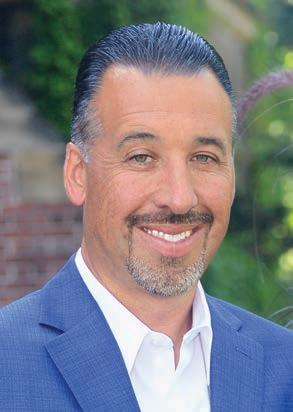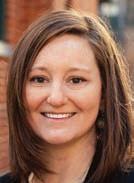Wingtips, meet Jumpman
BY JOE SCALZO
e trendiest dress shoes in America aren’t wingtips, but you can buy them with wings. ey aren’t designed for tuxedos, but you can get them with patent leather.
ey’re made to be worn on maple, but they’re increasingly found underneath cherry, oak and walnut.





ey’re called Air Jordans. And while millions of Americans have suited up with them since 1985, it’s increasingly likely they’re doing so while wearing a suit.
C-suiters, meet Js.
“Living in these times, people aren’t so uptight about the rules of out ts,” said Jevon Terance, an international fashion designer (and lifelong sneakerhead) from Lorain. “You can still be respected and still make CEO moves wearing a sneaker under a big desk.”
Of course, mixing sneakers and suits isn’t exactly new. Converse’s Chuck Taylors have always had a retro appeal, Will Smith was wearing Jordan 5s with a tuxedo jacket on “ e Fresh Prince of Bel-Air” as far back as 1990, and companies like Cole Haan have made a mint from selling dress sneakers. But dress sneakers are just that: sneakerized versions of dress shoes.


Air Jordans are di erent. ey were made for basketball courts, not boardrooms. While those two di erent arenas sometimes intersected during Jordan’s playing career, it was more niche, something you saw in hip-hop or skater culture.

MAGNET’s new headquarters aims for more



 BY RACHEL ABBEY MCCAFFERTY
BY RACHEL ABBEY MCCAFFERTY
e heart of MAGNET’s work has long been manufacturers.

But with the opening of its new headquarters in Cleveland’s Hough neighborhood, MAGNET’s scope is broader.











The new center is more than just a space for manufacturers to problem-solve and innovate. It’s a place for the community to gather, for children to play and for students to learn, for adults to train for new careers and for, yes, manufacturers to explore new technologies.
MAGNET: e Manufacturing Advocacy and Growth Network secured the space for its new headquarters at 1800 East 63rd St. in the fall of 2020. Ground broke on renovations at the building, the former Margaret Ireland school, in August 2021. MAGNET moved in to the new building this October, with formal opening events held the last week of the month.
Personal View: Ethan Karp, MAGNET CEO and president, explains vision behind new headquarters. Page 8
A changing of the guard at the 5th Street Arcades
BY MICHELLE JARBOE
e local developer who transformed a pair of moribund retail arcades in downtown Cleveland into an eclectic business incubator has handed over the keys, passing control of the property to global real estate giant CBRE Group Inc.

In September, developer Dick Pace ended a decade-long run as the master lessee and manager of the 5th Street Arcades. e 60,000-square-foot property is a rare retail bright spot in a downtown where shopping, particularly at malls and other indoor centers,
has struggled. Now tenants are wondering what the future holds.

“I had a 10-year master lease at the arcades, and it expired,” Pace said. “I could have done a renewal for 10. But I’m 66. I just didn’t see myself doing it when I was 76.” e conjoined corridors, historically known as the Colonial and Euclid arcades, run between Euclid and Prospect avenues at the north end of the Gateway District. e property, owned by Summit Hotel Properties Inc. of Austin, Texas, also includes a 175-room Residence Inn hotel.

VOL. 43, NO. 40 l COPYRIGHT 2022 CRAIN COMMUNICATIONS INC. l ALL RIGHTS RESERVED CRAINSCLEVELAND.COM I OCTOBER 31, 2022 REAL ESTATE Krueger Group, RHM form joint venture for two Rocky River development projects. PAGE 2 CANNABIS : Market downturn highlights growing pains in marijuana industry. PAGE 10
New England Patriots owner Robert Kraft is known for wearing Nike Air Force 1s everywhere he goes, from the White House to his own wedding, while actor Jason Sudeikis wears Air Jordans with his out ts, from the Jordan 11s he wore at the Golden Globes to the Jordan 1s he wears on Ted Lasso. | ALAMY PHOTOS
JORDANS SNEAK THEIR WAY INTO BUSINESS ATTIRE
The 5th Street Arcades are a rare retail success in downtown Cleveland, which has struggled to repopulate its shopping centers. | MICHELLE JARBOE/CRAIN’S CLEVELAND BUSINESS
See JORDANS on Page 16 BRAD STARKEY/UNSPLASH See RETAIL on Page 15
See MAGNET on Page 17
JOINING FORCES
Realty rms form joint venture for two big-ticket Rocky River developments
BY STAN BULLARD
When real estate developer Bobby Krueger, president of the Krueger Group of Cleveland, was a teenager, he often worked in a building in downtown Rocky River that was owned by his father, Robert Krueger, the chair and founder of Krueger Group.
Now the younger Krueger — along with the family-owned building and development rm — has formed a joint venture with John Joyce, CEO of RHM Real Estate of Lyndhurst, to put their own mark on the suburb’s historic downtown.
rough a series of a liates named Ingersoll I, II and III, the companies in September acquired a small one-story industrial building on Ingersoll Drive, parking lots and a grassy piece of property to make up a 6-acre parcel for redevelopment in downtown Rocky River. Public records do not include a sale price for the transactions, which are between Linda Street and Smith Court.
Krueger and Joyce said in a Zoom interview they are still kicking around ideas for the nal plan for the property but have some ideas in mind. Meantime, construction is starting on another collaboration, a 96-unit apartment complex on Center Ridge Road in Rocky River.
“We’re excited to nd the highest and best use for this site, which has so much upside,” Krueger said.
Joyce said, “We have discussed a mixed-use approach with residential, commercial and o ce use.”
Other elements of the project could incorporate a gastropub, a

restaurant and a food hall.
Krueger noted the business zoning of the site allows the duo to have great exibility in planning the project.
“We know what will work,” Krueger said. “What (Joyce) and I are thoughtful about is how we serve the community at large. We want to work with the city and major stakeholders to develop a plan bene cial for everyone. e area has parking problems. We are not just developers but long-term holders of property. It’s going to be an iterative process.”
e West Side suburb’s master plan identi es the parcel as a signicant opportunity in the city.
she tells constituents complaining about the condition of the road that the city cannot repair a private street.
e parcel is close to Old Detroit Road, a grouping of trolley-era buildings regarded as the historic downtown in the suburb, but the area considered downtown Rocky River has expanded through the years with additional retail and o ce uses spanning multiple blocks. It is also close to Beachcli Market Square, an upscale shopping center that includes the repurposed former Beachcli movie theater.
A long-term proposal in Rocky River city plans calls for eliminating the Marion Ramp to the Clifton Road Bridge and replacing it with a more pedestrian-friendly street network. at would boost connectivity within what the suburb dubs its downtown area, especially for the Ingersoll-Linda area.
“We have construction and development expertise,” Krueger said, “and we needed apartment management and leasing expertise, which RHM has, along with development expertise.”
Meantime, Joyce said he wanted to move RHM Real Estate, which owns 10,000 apartment units in 13 states, into the real estate development side of the multifamily business. e two were introduced by their mortgage broker, Jim Doyle, a principal of the Bellwether Enterprise mortgage banking and brokerage rm based in Cleveland.
As they discussed and decided to proceed together on the ground-up apartment project, the two realized they were also both weighing a quite di erent sort of project in downtown Rocky River.

access to outdoor space off their units in the event another pandemic hits and they are locked in their apartments/homes,” Krueger said.
“All the units will have walk-out balconies in case there is a quarantine. They will include dedicated workspaces and an on-site fitness center.”
e complex will include a pool, outdoor grilling areas, a gazebo and a walking trail, Joyce said. e building’s lobby will also serve as a lounge area for tenants who want to relax outside their suites.
Rocky River Mayor Pam Bobst said in an interview that she and others in the city are excited to see what the developers “envision for the site.” She noted that the prior owner, who held the parcels under T2 Rocky River and Smith Court Lot LLC, had accomplished a feat by assembling the adjoining properties over several years.
“One of the reasons the site is so large is that Ingersoll Drive is not a public street,” she said.
“It is privately owned and part of the potential project site.” She noted
e Krueger-RHM Ingersoll site’s immediate surroundings are an eclectic mix of commercial and residential buildings repurposed as restaurants, o ce buildings and shops. Bobst noted the city’s former service garage on Linda Street now serves as the home of the Market restaurant.
Ironically, both real estate developers had sized up the site separately, which they learned as they started on a potential joint venture to develop a 96-suite apartment complex on western Center Ridge Road in the suburb.
Although the joint venture on Ingersoll is nascent, construction at the so-far-unnamed apartment complex at 22591 Center Ridge is ramping up. Pride One Construction Services of Medina has put its construction trailer on the site along with fencing to secure the building site.
Designed by Dimit Architects of Lakewood, the brick rst building will rise four oors and consist of 54 units. Completion is expected in spring 2024. e second building will be the same height and consist of 42 suites and will be constructed later.
e COVID-19 pandemic will give new purpose to some typical design features of apartments.
“What we learned from the quarantine is we need to give residents
Although Northeast Ohio has had more apartments constructed recently than in decades, the Rocky River apartments may have hit a particular sweet spot. No new apartments have been built in the suburb since 2012, and that project was the rst since the 1970s.
“Occupancy in the west suburbs is 98%,” Joyce said.
e two will not disclose the projected rent range for what they described as an upscale multifamily community, nor a proposed cost for the Center Ridge apartments.
“We’ll be careful not to price ourselves out of the market,” Krueger said.
Bobst said Rocky River is pursuing long-range plans to make ve-lane Center Ridge more desirable as a walkable area by modernizing the right-of-way.
“Every fourth step on sections of the road crosses a driveway apron,” she said.
Stan Bullard: sbullard@crain.com, (216) 771-5228, @CrainRltywriter
2 CRAIN’S CLEVELAND BUSINESS | OCTOBER 31, 2022 REAL ESTATE
A joint venture formed by RHM Real Estate of Lyndhurst and Krueger Group of Cleveland is starting to build an apartment project in Rocky River. | DIMIT ARCHITECTS
“WHAT (JOYCE) AND I ARE THOUGHTFUL ABOUT IS HOW WE SERVE THE COMMUNITY AT LARGE. WE WANT TO WORK WITH THE CITY AND MAJOR STAKEHOLDERS TO DEVELOP A PLAN BENEFICIAL FOR EVERYONE. ”
—Robert Krueger, chair and founder of Krueger Group
Welty’s In-Site unit gets a new president

For more than a decade, Sean Joyce has been a steward of North east Ohio’s past.
Now he’s probably going to be shaping its future.
After an 11-year stint at Stan Hywet Hall & Gardens in Akron, including three as president, Joyce is set to be come president of Welty Building Co.’s In-Site Advisory Group on Mon day, Oct. 31. It’s a role that will have him working with public and private entities as they seek new locations and manage their real estate and de velopment projects.
He gures he’s up for it.
“I really enjoy working on projects, helping organizations build and make improvements that will help them be successful,” Joyce said. “I’ve had a lot of experience with nonprof its and at Stan Hywet I helped build a for-pro t construction company called ARRC (Architectural Resto ration and Renovation Consultants).”
His new boss, Welty CEO Don Tay lor, also thinks Joyce has what it takes to manage what Taylor said is an im portant, growing component of his business. It’s also the unit that serves as Welty’s starting point for major de velopment and construction proj ects.
“ is is a big deal for us,” Taylor said.
Joyce is taking on a position that’s been vacant since Jennifer Syx left to form her own rm, J6 Advisors in Cuyahoga Falls. It’s also a role Taylor said he’s expanding at a business unit that is growing in scope.
In-Site recently began o ering owners-representation services, which Taylor said it has recently em ployed with Goodyear and some oth er major clients. It will be adding sta to help it further work with owners to manage their development projects, and In-Site will be growing generally, Taylor said.
“ e intention is that we will prob ably triple the size of In-Site,” Taylor said.
e unit, which now has four pro fessionals, will add another nine or 10 people, most of them devoted to its owners-rep business under Joyce, according to Taylor.
In-Site is not a huge portion of Welty’s total business, but it punches above its weight in terms of its overall e ect on the company, Taylor said. It not only brings big projects to Welty but is instrumental in helping major companies expand in the region or to build new headquarters and other fa cilities that will keep them here, Tay lor said.
“Traditionally, it has not been a great revenue generator, but the business makes a tidy little margin ... it’s small, but it’s a nice little busi
ness,” Taylor said. “It’s a nice contact with people who are thinking about building, so it’s a gateway. … It’s the very rst opportunity we have with a client.”
Taylor said In-Site was Welty’s doorway to handling CBIZ’s new headquarters in Independence, a project for which In-Site helped the developer with nancing and in which Welty has taken a leading role.
“Now we’re building a 150,000-square-foot building for CBIZ that Welty will ultimately own,” Taylor said. “If it were not for In-Site’s work, Welty probably wouldn’t have been involved.”
In-Site has worked with Dealer Tire in Cleveland, helping the city to keep the company at a new location in Midtown. It also has worked on projects like the Kay Pavilion at Ak ron Children’s Hospital, employing lean construction and integrated project development strategies.
“We ended up bringing in millions (of dollars) of savings,” Taylor said of the Kay Pavilion project.
Taylor said he’s seen that more and more owners and end-users are look ing for consultants and developers that can do more than just build — and they want both advanced con struction techniques and help with overall project management.
e Welty CEO, who can seeming ly not have a conversation without
using the term “horizontal integra tion,” said he’s continually working to adapt his company to ful ll a larger role and meet more of its clients’ needs.
Joyce and Taylor know each other through Jerry Welty, the company’s past president and Taylor’s original partner at the company. Both Welty and Joyce were active with Goodwill Industries in Akron, Taylor said.
at’s part of the reason Taylor is comfortable with his new hire, but he said his con dence also comes from Joyce’s broad background in con struction and nance.
Joyce said several of his past posi tions have given him experience he plans to bring to his new job.
At Stan Hywet for 11 years, Joyce worked on maintenance and con struction projects, as well as helping launch and then run the ARRC con struction business, he said.
Before that, he managed facilities and nance for Goodwill in Akron, and in the ’90s, he was chief nancial o cer for APCOA Parking in Cleve land, where he worked on national projects, including a $50 million outof-state garage development, Joyce said.
“I’ve been fortunate in my career to pick up a broad skill set and some knowledge,” Joyce said. “I got to see a lot. I also got involved with a lot of ga rage construction projects and the -
nancing for those … so I got a well-rounded education in what it takes to put a project together and get it done.”
He plans to hit the ground run ning, he said, and answered the phone in his new o ce nearly a week before his o cial start date.
“We’re working on some bids right now,” Joyce said. “And (I) have a few projects I’m bringing in on my side of things, too. … It’s a great opportunity. Don, the way he looks at things is not just as a business, but as a way to im prove things in the community, so I think we’ll have some interesting projects.”
Dan Shingler: dshingler@crain.com, (216) 771-5290
OCTO BER 31, 2022 | CR AIN’S CLEVE LAND B USIN E SS 3
Now, the local health insurer you know and trust can offer you superior dental benefits with one of the largest networks in the country.
Learn
how Ohio’s health and dental experts can keep your employees smiling. Visit MedMutual.com/Together, call 1-800-409-2595 or talk to your broker.
AKRON
DAN SHINGLER
Sean Joyce will succeed Jennifer Syx as president of Welty Building Co.’s In-Site Advisory Group. CONTRIBUTED
Walter Haver eld to drop some practice groups amid refocus
BY JEREMY NOBILE
An economy-wracking health crisis prompted some soul searching for Cleveland’s 90-year-old Walter Haver eld that will culminate in some big changes for the law rm in 2023.
“I think the pandemic caused a lot of things to come into focus,” said Ralph Cascarilla, Walter Havereld’s managing partner for the last two decades. “ ese things cause you to start to think through what it is that you are doing and whether you can do it better.”
E ective Jan. 1, Walter Haver eld will release its public law and education law practice groups.
at action is expected to impact roughly 40 employees, including 25 attorneys, said administrative partner Kevin Murphy. He and Cascarilla characterized the move as an amicable split.
Some leaders of those practice groups invited to weigh in on the move did not immediately respond to a request for comment.
e departing personnel amount to about 30% of the rm’s attorney bench in the local market, according to Crain’s research.

e business reported 94 attorneys rmwide, including 84 in the Cleveland market, for the Crain’s 2022 law rms list, ranking Walter Haver eld as the ninth-largest law rm in Northeast Ohio.

Separating from those people and practices is not a decision that was taken lightly, Cascarilla said, and is driven by a strategy for what practice areas the rm wants to focus on moving forward, namely those centering on corporate work and private entities.

While the rm’s roots have historically been in labor and employment with some public entity representation, its public education practice in particular is one that developed under Cascarilla’s tenure as managing partner.
But as the rm’s dual work in public and private arenas has grown in tandem, that has presented some con icts between the two.
“As we expanded representation, and as you get larger and have a bigger footprint in the marketplace, these things start to be in con ict,” Cascarilla said. “ at was one of the major precipitating factors in why
we talked about this idea of a transition.”
“ ese are very good lawyers in their practice areas,” he added. “We just assumed, as we looked at it, that what would be better for both sides if there were clarity for their practices in a di erent format.”
e rm has, in fact, placed a greater focus on work in the private sector in recent years.

is is underscored by the rm’s 2019 acquisitions of Hurtuk & Daro , a real estate and nance rm in May eld Heights, and Nardone Ltd., a tax planning and business services rm in Columbus. Both roll-ups marked the rm’s rst and only acquisitions since its founding in 1932.
“ is decision is really an outgrowth of our focus and expansion over the years,” Cascarilla said. “We have made a concerted e ort to develop the corporate tax and commercial litigation components of the rm. And as we have expanded our real estate practice as well, we bump up to some issues with public entities, and con icts develop.”
Lawyers, of course, charge higher rates in the private sector than they do for public entities.
But the dropping of these practices is not a re ection of any need to cut costs or cut loose underperforming groups, Cascarilla said. He emphasized that Walter Haver eld — which has certainly garnered a reputation in the market for its scally conservative approach to business — is “doing well nancially” and the impacted personnel have made meaningful contributions to the rm.
“I look at this rst and foremost as an issue about the focus of representation, our ability to represent a certain type of client and what that means to us as a rm,” Cascarilla said. “ e needs of the di erent practices combined with the inherent con icts that can come about are the factors that really compelled and in uence the decision-making process internally.”
Where the departing lawyers go from here is to be seen.
But observers of the legal market are con dent they’ll be in demand.




“ is is the rst I’m hearing about it, but I can think of a couple law rms that, when they hear this, I think they’ll want to go after those lawyers,” said Rebecca Ruppert Mc-
Mahon, CEO of the Cleveland Metropolitan Bar Association. “I think there will be some excitement in the marketplace to pick up these practice areas.”
“ ese are great lawyers,” added Murphy. “We like working with them. It just became a matter of t and focus and the path forward. We are determined to focus on commercial real estate, tax and corporate litigation practices that have been some of the biggest drivers of our growth the last 10 years in attorneys and revenue.”


e rm is an aggressive lateral hirer and will continue looking to add people to its practice areas of focus in the private sector.
As far as other moves in store for the rm, Cascarilla notes that he will not run for another term as managing partner after his current term ends March 1.
As administrative partner, Murphy could be in line for that role. But partners will ultimately vote on their rmwide leader next year.
Cascarilla, who has no immediate plans to retire, said he’s looking forward to devoting more time to his own practice areas, which include a combination of commercial and environmental litigation.

“I have indicated to the partners that I am happy to do whatever in terms of management that they might need me for,” Cascarilla said. “But I have missed having the amount of time that I would like for my personal practice.”
e rm is also reconsidering its o ce needs as it looks to the future, which has been a common theme among professional services businesses in the wake of the COVID-19 pandemic.

It was less than two years into Cascarilla’s rst term as managing partner that Walter Haver eld set up shop at the Erieview Tower in downtown Cleveland.
But with a moderate downsizing in store and the rm’s lease expiring in November 2023, management is considering a move — though there is every intention to remain headquartered in Cleveland.


“We’re looking for something a bit smaller that is more e cient and modern,” Murphy said. “So there will be some cost savings there. We also have more people working from home, which is part of it, too.”
Nobile: jnobile@crain.com, (216) 771-5362, @JeremyNobile










4 CRAIN’S CLEVELAND BUSINESS | OCTOBER 31, 2022 FOR SALE PRIME 5.3 AC REDEVELOPMENT SITE Southwest corner of Aurora Rd & Cochran Rd 32,000 SF building 16 condo units included Zoned Industrial (I-2) Potential for change of zoning to include highway services and restaurants Priced for Sale at: $5,500,000 430’ x 445’ 216.861.5349 tonyvisconsi@hannacre.com Tony Visconsi 29500 Aurora Road, Solon, OH 44139 PROPERTY OVERVIEW RATE DIMENSIONS Personalized Service! Loans up to $30 Million • No Prepayment Penalties Investment & Owner-Occupied Commercial Real Estate DON’T BE SPOOKED BY INTEREST RATES YOUR LOCAL CREDIT UNION IS HERE TO GUIDE YOU THROUGH YOUR COMMERCIAL REAL ESTATE LOANS CONTACT JONATHAN A. MOKRI 440.526.8700 • jmokri@cbscuso.com www.cbscuso.com Straight Talk, Smart Deals ®
Walter Haver eld is reconsidering its o ce needs as it looks to the future, which has been a common theme among professional services businesses in the wake of the COVID-19 pandemic. | CONTRIBUTED
LAW
Jeremy
Cascarilla
Drilling into the data pays o as workforce plans align in region
 KIM PALMER
KIM PALMER
Earlier this year, Lorain County Community College (LCCC) sat down with Team NEO to develop a program that would help the school’s sta better explain and steer students toward the region’s high-in-demand jobs and careers.
With around 90% of LCCC stu dents choosing to remain in North east Ohio, those potential workers are an integral component of mis alignment in the region’s talent pipe line, said Marisa Vernon White, LC CC’s vice president of enrollment management and student services.
“We want to be better at having those important ca reer conversations with students, upfront about where the jobs actually are, so they are making in formed decisions.”
Working with the data from a suite of Team NEO annual and quarterly re ports, including the sixth annual “2022 Aligning Op portunities in Northeast Ohio,” a tal ent report on the region’s overall workforce supply and demand im balance released ursday, Oct. 27, White and her colleague omas Jay Benjamin, LCCC’s director of institu tional research, together developed “Careers by Design.”
e 12-hour, ve-part professional development program was rolled out to about 40 sta ers working directly with students and focuses on best practices in advising and guiding po tential workers to careers in three main industries. ose are health care, which, according to Team NEO in 2021, had total demand for nearly
WEEK
AIMING FOR $100M: A waterfront apartment building at the Flats East Bank in downtown Cleveland is hit ting the market, as a mezzanine lender on the project takes steps to foreclose. e future of the 240-unit apartment building, called the Flats at East Bank, is in ux in the wake of developer Scott Wolstein’s death. Wolstein, who was 69, died in May, six months after being diagnosed with an aggressive cancer that quick ly robbed him of his ability to speak. Now Institutional Property Advisors Midwest, a division of the Marcus & Millichap real estate brokerage, is preparing to list the Flats at East Bank for sale. Meanwhile, a lender is moving to assert its right to take con trol if a compelling purchase o er doesn’t materialize. ere’s no for mal asking price for the property, which also includes indoor parking and 60,000 square feet of groundoor retail. But IPA Midwest is aim ing for close to $100 million. at would be enough to repay $96 mil lion in rst-mortgage and mezza nine debt listed in public records.

CHANGE AT THE TOP: Jennifer A. Parmentier will become the next CEO of Parker Hanni n Corp. on Jan. 1, 2023. e May eld Heightsbased motion and control technolo gies company announced Parmen tier will succeed omas L. Williams, who has served as the company’s CEO since 2015. Wil liams will continue to serve as exec utive chairman of the board
50,000 workers; followed by manu facturing, with nearly 27,000 jobs; and IT, with a need for more than 15,000 workers.
e workforce data in the most re cent report has no big surprises, ac cording to Jacob Duritsky, vice pres ident of strategy and research at Team NEO. Northeast Ohio is still in need of more skilled talent, and the region continues to see declines in both population and the labor force, which was only further exacerbated by pandemic losses.
But there is some good news.
After more than half a decade of digging into the workforce problem, the reports continue to contain better data based on robust community in put, resulting in key nd ings. ose ndings are helping shape a broader regional discussion about how to bring more skilled candidates into the work force and create a consen sus of partners all working together and “moving in the right direction,” he said.
“ e mismatch between supply and demand has not really changed, but what is continuously changing is the development of higher educa tion and workforce programs work ing on this across the region,” Du ritsky said. “Six years later, we’ve helped elevate the conversation and, more importantly, created a lot of strategic alignment.”
LCCC became part of that conver sation when, as White explains, the school wanted a broader, quanti able view of the region’s employ ment needs. e career program that as a result was created and im
plemented in less than a year has been “transform a more diverse population of students into those programs.
“We recognized we need to give our advisers, career counselors and outreach specialists different words to be able to describe to students what these jobs really look like,” White said.
One value of all the granular data in the Team NEO reports — which, over the past six years, have ex panded to include underrepresent ed populations in the region’s workforce — is the quantifiable numbers about job demand.
The Team NEO reports give ad visers the ability to point to hard data, Benjamin said. Pointing out that there was a need for more than 9,700 nursing and home-aid work ers in 2020 — and only a third of that number, 2,600 students, gradu ated that year with degrees or cre dentials to fill those jobs — makes it easier to convince students those health care jobs are actually a sta ble, long-term career choice, he said.
Melding the data with career planning is also transforming how LCCC works with students around education required for new IT ca reers in the areas of cybersecurity, data visualization or micro me chanical engineering, which is re lated to semiconductor chip manu facturing, which most people do not know even exist.
Case in point, since the comple tion of the career training series, LCCC experienced double-digit percentage growth in computer maintenance and networking, cy bersecurity, data analytics and mi
cro electrical mechanical systems program enrollment for the 202223 academic year.
LCCC advisers are also better able to talk about matching up a student’s interest or passion and a career or job in the IT field.
make more than $50,000 a year and do not require a four-year degree. Some of those jobs need only a one-semester class, White points out, and many are good entry-level jobs with room for advancement. The goal is to work with employers to identify what training is neces sary to get some body in the door. From there, schools can offer training and cer tificates to help enhance skills without keeping employers wait ing for workers, White said.
“Advisers now are able to really laser-focus in on what a student might want to pursue — for exam ple, a creative arts degree can have skills that apply to robotics or com puter process design,” Benjamin said. “Also, some of our advisers who work closely with social sci ence students now point to data an alytics as something that would po tentially resonate with them.”
The newest Team NEO report also highlights the region’s top 20 jobs that require an associate’s de gree or less; are expected to be in high demand for the next five years; and pay a more than self-sustaining wage in Cuyahoga County, which is at least $32,531 a year.
In the region, light truck drivers; industrial machinery mechanics; plumbers and pipefitters; insur ance sales agents and adjusters; heavy equipment mechanics; heat ing and cooling mechanics; and electricians are all in high demand,

“Short-term training is some thing that resonates with people, that immediate return on invest ment. The ability to take that shortterm certificate or that short-term credential and then add to that as they’re working is very popular,” White said.
The LCCC program has been so successful White and her team have modified the sessions for those in and outside of the school.
“We realized how valuable the information was around talent gaps, so we condensed the infor mation into a highlight session last ing about 90 minutes for faculty and staff not working directly with students, like marketing and com munication, and we have also start ed including some of our other higher education partners,” White said.
Kim Palmer: kpalmer@crain.com, (216) 771-5384, @kimfouro ve

throughout 2023, and he will retire from both the board and the com pany at the end of that year. Par mentier became Parker’s chief oper ating o cer in 2021, having previously served as the company’s vice president and president of the motion systems group from 2019 to 2021 and of its engineered materials group from 2015 to 2019. Andrew D. Ross will take on the COO role when Parmentier becomes CEO. Ross also has a long history of leadership with the company, including his current role as vice president and president of the uid connectors group, which he has held since 2015.
KEEPING BUSY: SITE Centers, the Beachwood-based real estate invest ment trust, shed 15 plazas for $451 million and continued its “buy
small” campaign by purchasing ve convenience centers for $31 mil lion. e disposition and acquisi tion updates were included in the shopping center owner and manag er’s nancial report released Tues day, Oct. 25, covering the third quarter ending Sept. 30. Typical of the sales side of the ledger, SITE Centers sold Perimeter Center, a 136,000-square-foot shopping cen ter in Columbus, for $35 million, ac cording to the company’s nancial supplement. On the buy side, the company bought Parkwood Shops in Atlanta for $8 million, and a port folio of four plazas in Phoenix for a total of $23 million. e ve centers in total added just 52,000 square feet to SITE Centers’ portfolio and ranged in size from 4,000 to 20,000 square feet.
OCTO BER 31, 2022 | CR AIN’S CLEVE LAND B USIN E SS 5 GOVERNMENT
THE
The Flats at East Bank apartment building is being put up for sale in the wake of developer Scott Wolstein’s death. | MICHELLE JARBOE/CRAIN’S CLEVELAND BUSINESS
Vernon
“THE MISMATCH BETWEEN THE SUPPLY AND DEMAND HAS NOT REALLY CHANGED, BUT WHAT IS CONTINUOUSLY CHANGING IS THE DEVELOPMENT OF HIGHER EDUCATION AND WORKFORCE PROGRAMS WORKING ON THIS ACROSS THE REGION.”
—Jacob Duritsky, vice president of strategy and research at Team NEO, Northeast Ohio
Lessons learned?
For some truly scary late-October reading, check out the re sults of the new National Assessment of Educational Prog ress, a national report card on how U.S. students are doing.

e 2022 NAEP was the rst time the test had been given since 2019, so it provides a glimpse of the pandemic’s impact on learning. Its results, released last week, were awful, with math scores recording their largest decreases ever, and read ing scores dropping to 1992 levels.
e Associated Press noted that “several major districts saw test scores fall by more than 10 points.” Cleveland saw a drop of 16 points in fourth-grade reading. Declines of even a couple points are considered cause for concern. Students with dimin ished reading skills present a particularly vexing problem be cause they tend to have di culty learning other subjects.
Eric Gordon, the outgoing CEO of the Cleveland Metropolitan School District, told the AP the report was “more con rmation that the pandemic hit us really hard.” He added, ruefully, “I’m not concerned that they can’t or won’t recover. I’m concerned that the country won’t stay focused on getting kids caught up.”
One report isn’t everything, but mounting evidence makes it clear that pandemic lockdowns that prevented in-person learning in some places for too long had signi cant educa tional and social consequences for children. From an equity standpoint, it’s important to note that kids in city schools were far more likely than students from the suburbs to have to try to learn remotely. Workers might have made peace with Zoom; for kids, it’s mostly no good.
Over the long haul, those setbacks could have serious impli cations for the preparedness of the workforce, both in terms of their skills and their emotional preparedness for work. Given the struggles many companies already have in nding the em ployees they need, this is not a good sign for what lies ahead. e past can’t be changed, but districts can use it to draw better lessons for the future, starting with the preparation of plans to keep schools open as much as possible if/when the next pandemic (or some other calamity) hits. Cleveland beefed up summer school and added after-school training to help students make up lost ground, but Gordon’s successor should be pressed to detail how the district over time will help erase these serious learning losses.
Teachers have incredibly di cult jobs, and you won’t nd us criticizing them. But teachers unions heavily in uenced decisions on closures, and while we understand their interest and duty in keeping members safe, their discussions with dis tricts on future safety measures have to be predicated on ed ucating kids in person to the largest degree possible.
We all hope there’s no follow-up pandemic to manage. But if there is, schools have to manage the risk so we don’t doom generations of students to inferior educations that set them back a lifetime.
Change in motion
PERSONAL VIEW
Medicare’s annual wellness visits are underused. at needs to change
More than 10 years after it was es tablished as part of the Affordable Care Act, fewer than 20% of Medicare pa tients are getting an annual wellness visit (AWV) — that dedicated primary care encounter that focuses on sched uling preventive services such as vac cinations, bone density tests and screening tests for cancer, chronic con ditions and cognitive problems.
Patients are missing out on some clear benefits, including greater use of preventive services to detect or stave off disease and lower personal Medi care spending. Data on the effective ness of annual wellness visits contin ues to emerge. In fact, just this past summer, researchers from the Univer sity of Virginia reported results show ing that patients with diabetes who get one of these free visits are 36% less likely to need major lower-extremity amputations.
With such a significant upside for patients, what accounts for the low numbers when it comes to these free preventive care visits? Confusing cov erage rules under Medicare may be partially to blame. Medicare does not cover an annual physical exam, where the provider surveys the body for dis ease, measuring height, weight and blood pressure and listening to the pa tient’s heart and lungs. But it does cov er an annual wellness visit, which is more of a conversation and less of an exam.
P
arker Hanni n Corp. will get a new CEO on Jan. 1, 2023, putting a new executive in charge of a multibillion-dollar advanced manufacturing powerhouse. e move also will grow the small ranks of Ohio’s largest public companies that are led by women.


e May eld Heights-based motion and control technologies company announced that Jennifer Parmentier will succeed omas Williams, Parker’s CEO since 2015. Parmentier has worked at Parker since 2008 and became its chief operating o cer in 2021. She previously worked at Ingersoll Rand Trane Resi dential Systems and Magna Corp.

When Parmentier becomes CEO, she’ll be the fourth woman at the helm of one of Ohio’s 50 largest public companies, based on 2021 revenue. e others, according to Crain’s Ohio Public Companies list published Aug. 1, are Progressive Corp.’s S. Tricia Gri th, Bath & Body Works Inc.’s Sarah Nash (she’s interim in the role) and Fran Horowitz of Abercrombie & Fitch Co. We point this out not to praise or second-guess speci c decisions on CEO hir ing, but to underscore that everyone bene ts when companies are casting the widest net possible when looking for executive talent — including (and maybe especially) at the top. e num bers suggest that still doesn’t happen for women in CEO posts.
It would help Parker and all of Northeast Ohio if Parmentier is great in this job, as we expect. And it would be great for Ohio corporations to make more progress in opening up the C-suite to those traditionally excluded.
Executive Editor: Elizabeth McIntyre (emcintyre@crain.com)
Managing Editor: Scott Suttell (ssuttell@crain.com)
Contact Crain’s: 216-522-1383
Read Crain’s online: crainscleveland.com
For patients and most clinicians, the distinction may seem meaningless — until patients get the bill for an un covered physical exam. The resulting sticker-shock may turn them off of preventive care entirely no matter what it’s called, further depressing the number of patients tak ing advantage of annual wellness visits. Patient education on the differences between the two kinds of clinical en counters can help. However, knowing to ask for an annual wellness visit and not a physical exam is asking a lot for even the most savvy Medicare patient.
Hospitals and health systems have also failed to make Medicare annual wellness visits a priority. In an industry known for innovation in quality improvement, health care has produced just two small efforts to boost the numbers.
Where does that leave us? Changing the narrative on annual wellness visits will require taking the onus off pa tients to navigate the complexities of Medicare and in stead putting responsibility on hospitals and health sys tems to build systems to be proactive in getting their Medicare patients scheduled for this vital service.
At our institution, we launched a multifaceted quality im provement e ort to boost annual wellness visits for our Medicare patients in 2018. Like many hospitals and health
Write us: Crain’s welcomes responses from readers. Letters should be as brief as possible and may be edited. Send letters to Crain’s Cleveland Business, 700 West St. Clair Ave., Suite 310, Cleveland, OH 44113, or by emailing ClevEdit@crain.com. Please include your complete name and city from which you are writing, and a telephone number for fact-checking purposes.
Sound o : Send a Personal View for the opinion page to emcintyre@crain.com. Please include a telephone number for veri cation purposes.
6 CRAIN’S CLEVELAND BUSINESS | O CTOBER 31, 2022
EDITORIAL
RICH WILLIAMS FOR CRAIN’S CLEVELAND BUSINESS
DR. PETER PRONOVOST, DR. TODD ZEIGER AND DR. SONA KIRPEKAR
Pronovost, Zeiger and Kirpekar are University Hospitals medical doctors.
See MEDICARE, on Page 18
meet future



 BY MARCIA BALLINGER
BY MARCIA BALLINGER
As Manufacturing Month spans the month of October, our region is perfectly poised to lead the future of manufacturing, a future fueled by opportunities in semiconductors, microelectronics and increased automation.


Intel’s new, leading-edge semiconductor manufacturing plant represents one of Ohio’s greatest economic opportunities, as its presence is certain to drive unprecedented supply chain growth throughout the state. It’s not just about one company coming to Ohio — it’s an entire industry embedding itself in Ohio, creating the Silicon Heartland.


Long before Intel’s historic groundbreaking ceremony near Columbus, Lorain County Community College (LCCC) was ready. For more than a decade, LCCC has been developing unique expertise in semiconductor and microelectronic manufacturing education and training. LCCC o ers Ohio’s only associate of applied science and bachelor of applied science degrees in microelectronic manufacturing, preparing students for work in the exploding semiconductor industry.
Both programs have boasted 100% job placement rates for our graduates, in part because of innovative earn-and-learn paid internship opportunities built into the curriculum working with over 80 Northeast Ohio
WE ARE READY FOR THIS MOMENT BECAUSE LCCC HAS DONE WHAT COMMUNITY COLLEGES ARE UNIQUELY DESIGNED TO DO — COLLABORATE WITH EMPLOYERS TO ANTICIPATE FUTURE TALENT NEEDS AND RESPOND SWIFTLY TO MEET THEM.
employers. ese types of integrated solutions led Harvard University’s Project on Workforce to pro le LCCC as one of ve exemplary community colleges in a forthcoming publication: “America’s Hidden Economic Engines: How Community Colleges Can Drive Shared Prosperity.”

As serendipitous as it all might seem, we are ready for


Ballinger is president of Lorain County Community College and co-chair of TeamNEO's Talent Development Council.




this moment because LCCC has done what community colleges are uniquely designed to do — collaborate with employers to anticipate future talent needs and respond swiftly to meet them. We will continue to forge partnerships to realize the full potential of this opportunity.
Intel recently named LCCC as one of eight higher education institutions in Ohio to lead its workforce investments. LCCC also joined the Midwest Regional Network for Semiconductors and Microelectronics, teaming up with institutions such as Ohio State University, Case Western Reserve University and Purdue University, among others, to address the broader, national e orts to promote U.S. leadership in semiconductors and microelectronics.
is proactiveness ensures residents have the opportunity today to train for and excel in the jobs of tomorrow.



LCCC’s innovative bachelor of applied science degree in microelectronic manufacturing and the college’s newly launched bachelor of applied science in Smart Industrial Automated Systems Engineering Technology will serve as a core curriculum for our Silicon Heartland’s training needs. And both build upon the success of LCCC’s longstanding University Partnership.
Now celebrating its 25th anniversary, the University Partnership delivers more than 100 bachelor’s and master’s degrees from 15 Ohio colleges. ese degree programs are o ered on the LCCC campus and save students an average of 70% on the cost of a bachelor’s degree. And after graduation, LCCC and University Partnership students nd career success right here in our region, as 90% of our graduates live and work in Northeast Ohio.
To secure the momentum of the University Partnership and all LCCC’s programs and services, we are asking voters to support Issue 10 on the Nov. 8 ballot. Issue 10 is a renewal levy and will not increase taxes. Issue 10 is an investment in our region’s future; it’s an investment that fuels this momentous transformation that’s unfolding here in Ohio.
Crain’s got it wrong with endorsement
Crain’s endorsement of Mike DeWine for governor is shockingly dismissive of his role in two recent scandals that a ect every single Ohioan and of which we should all be aware.

First, the FirstEnergy/House Bill 6 bribery scandal was unlike anything this state has seen in recent history. DeWine was, of course, involved in negotiations and passage of this disaster of a bill, and he signed it into law. He was responsible for appointing the head of PUCO (Public Utilities Commission of Ohio), who accepted millions from FirstEnergy and was raided by the FBI. e details of this whole saga are appalling, and, as governor, DeWine was in the midst of it all. Ohioans remain on the hook for millions in subsidies to energy companies and coal plants in Indiana as a result of his mismanagement.
Second, DeWine has done nothing to respond to the mandate from 70% of Ohioans to x gerrymandering in our state, and he has further ignored multiple orders from the Ohio Supreme Court to adopt constitutional maps. In fact, he called the maps “unconstitutional” but voted for them anyway. is is a agrant violation of his oath of o ce, yet such a tedious topic, I don’t blame most Ohioans for failing to pay attention. But we must.
His dereliction of duty cost Ohioans $20 million for an August primary that we did not need. Furthermore, the legislative extremism that results from gerrymandering like arming teachers (HB 99); forced “internal genital examinations” for child athletes (HB 151); and forced birth for victims of rape and incest (HB 258) is destroying our state’s economic outlook. Not surprisingly, Ohio’s brain drain has accelerated and young people are leaving in droves. Much of the responsibility for this lies at DeWine’s feet.
ese scandals are a result of a state where one party controls the politics to an extreme degree. Luckily, there is an alternative. Nan Whaley is running for governor and is a competent, level-headed leader who believes in representing the majority of Ohioans who just want the return of common sense and decency. Nan, like most of us, supports economic policies that will entice workers and new industries, help homeowners, make our schools and communities safer, and keep the government out of our private decisions. I urge voters to support Nan Whaley and reject Mike DeWine and the damage he has done to Ohio’s economy and prospects.
Jackie Godic Pepper Pike

OCTOBER 31, 2022 | CRAIN’S CLEVELAND BUSINESS 7
PERSONAL VIEW OPINION LCCC ready to
talent needs of employers
HOW TO FLY WITH SKY QUEST: » On-Demand Charter » Jet Club Memberships » Aircraft Ownership Opportunities 216-362-9904 Charter@FlySkyQuest.com FlySkyQuest.com Private Travel Made Easy Zoned PDD • 10,500+ VPD 2 Miles From I-70 • 20 Minutes From Downtown Columbus 11 Miles From the New Intel Factory Directly in Front of Heritage Town Center Apartments GROUND LEASE OR 7200-7256 Hazelton-Etna Rd, Pataskala, Ohio 43062 Lot 1: 1 Acre • Lot 2: .35 Acres BUILD TO SUIT Nichole Booker, PhD. Senior Advisor 330.475.5500 nichole.booker@svn.com Aaron Davis Senior Advisor 330.221.7297 aaron.davis@svn.com
LETTER
TO THE EDITOR
Why we’re creating the Disney World of manufacturing
ETHAN KARP
As the story goes, Walt Disney dreamed up Disney land while sitting on a bench in Los Angeles watching his daughters ride the carousel. He decided right there to build a park that transcended any single ride — a place for community, a place to learn something, a place where people would dream and be inspired.
If you could humor me, 70-odd years later I believe we’re doing something with a similar goal for manu facturing.
Last week, we o cially opened the Manufacturing, Innovation, Technology and Job Center, a facility that, like Walt and the carousel, is much more than a build ing. It’s a place to architect our industry’s destiny. e one envisioned in MAGNET’s Blueprint for the Future of Manufacturing in Northeast Ohio. Our goal is to transform the region into a global center for smart manufacturing, creating 30,000 jobs and boosting our GRP by $40 billion by 2032. e Manufacturing Center is where, together, we will make this happen.
It’s a place unlike anything else in the country. It’s a prototyping lab, a factory, a park, a museum, a workspace, a school, a technology accelera tor, and a gathering space. We’ll bring in more than 3,000 K-12 students every year, plus loads of current and prospective manufacturing employ ees to experience and learn what makes the industry not only vital for our country but a fun and rewarding career choice. Manufacturing is no lon ger reserved to dark and dingy warehouses — these are now high-tech ca reers earning quality pay. Here, students and companies can get hands-on experience interacting with the latest in Industry 4.0 technology, engaging with collaborative robots, real-time data monitoring, augmented reality, and the Internet of ings. And so can you — tours of our facility are free and open to the public.
NOT ONLY ARE WE EXCITED ABOUT THE PROSPECT OF BRINGING MORE VISIBILITY AND ACCESS TO MANUFACTURING VIA THIS HIGH-PROFILE SPOT, BUT WE ENVISION OURSELVES EMBEDDING WITHIN THE NEIGHBORHOOD IN A WAY THAT IS SYMBIOTIC.
So many manufacturers plant their roots far away from the inner city, but we have placed our building smack dab in the middle of Cleve land, in the up-and-coming Innovation District inside the historically disadvantaged Hough neighborhood. Our reasoning is two-fold. Not only are we excited about the prospect of bringing more visibility and access to manufacturing via this high-profile spot, but we envision our selves embedding within the neighborhood in a way that is symbiotic. We have, for instance, revitalized a long-abandoned school and built a massive STEM-themed playground to draw people in.
Hough is a predominately Black neighborhood, providing access to a talent pool that manufacturers have long failed to attract. By welcom ing our neighbors into our new home, we hope to create enthusiasm for our industry while placing more people of color in manufacturing jobs — great jobs that pay an average of $70,000. These can and should be the future leaders of our industry, and it starts with opening our doors.
And the state-of-the art machines and the building aren’t just for show. The facility has been built with a 20,000-square-foot prototyping lab so that small- and medium-sized manufacturers can access ad vanced equipment to build and launch new companies and products, with our engineering expertise to help along the way. What Silicon Val ley incubators are for tech startups — that’s what we are for manufac turers, bringing their ideas to life and to market, helping them scale their businesses.
Why is this all so important? We are at a critical turning point for American manufacturing. With the pandemic and geopolitical unrest wreaking havoc on our supply chains, there’s momentum to bring more manufacturing back to the U.S., as well as to build in additional capacity to handle surges in demand through advanced technology. Incoming federal grant dollars in the form of the Chips Act will help. The end goal is to become less dependent on other countries and cre ate more supply chain resilience here at home, steeling ourselves against future disruption. Northeast Ohio is positioned to play a funda mental role in this future. But it will only happen if we provide the manufacturing ecosystem with the tools and resources to create thriv ing, viable companies.
And it all starts with getting more people excited about manufacturing and seeing how it could make their lives better. We didn’t put in a roller coaster like Walt, but we could certainly build one if we wanted to.
O ces better for mingling than focusing
SARAH GREEN CARMICHAEL BLOOMBERG OPINION
e rise of remote work might be the best thing to ever happen to the o ce.
Until the COVID-19 pandemic up ended our work lives, the o ce func tioned as a do-it-all, be-everythingto-all-people space, balancing desks for individual work with conference rooms for team meetings and social areas for chit-chat. As a result, it did none of these jobs very well.
We ended up with open-plan spaces where sound carries freely — and with a lot of employees wearing headphones to block out the clamor.
ere are never enough conference rooms, so employees commute in just to meet over Zoom. It’s a space where it’s hard to be e cient, yet also hard to be collaborative and creative.

Fortunately, there is a way out of this morass. Embracing some degree of remote work eliminates the need for so many desks, freeing space that can be prioritized for what o ces do best: providing co-workers an oppor tunity to mingle.
It will take a di erent mindset on management’s part, but if leaders can embrace the idea that remote work is for concentrating and head quarters is for cooperating, o ces might become very di erent, and vastly superior: more meeting rooms, more social spaces, more natural light, more greenery. Executives might not be able to shorten the long commutes remote workers are des perate to avoid, but they can rethink what their o ces o er employees and, in so doing, make those treks more worthwhile.
e o ce of the future will be smaller, but nicer, says Diane Hoskins, co-CEO of design and ar chitecture rm Gensler, who is al ready seeing some clients adopt this type of layout. She says rms are pay ing more attention to amenities that really support social interaction among colleagues — Wi-Fi-enabled terraces, co ee bars, pool tables. Common areas with sofas, soaring ceilings and walls bedecked with
plants.
e o ce itself might be relocated to a part of town that’s closer to tran sit or near bars and restaurants where employees go after work. Relying on a communal fridge to foster employ ee interaction is out. Making the of ce feel like an upscale hotel lobby is in.
To really get employees to interact with each other, companies that pro vide food and drink should rethink how it’s presented, says Ben Waber, CEO of talent analytics rm Hu manyze. Rather than o ering premade co ee, an espresso machine gives people a chance to chat as they wait for the machine to do its work. Serving food bu et-style encourages employees to sit and linger over their meal, as opposed to pre-packaged lunches that workers can easily (and antisocially) bring back to their desks.
plans to repurpose its 500,000-square-foot Milwaukee headquarters, even as the company continues to bring employees to gether for speci c purposes like product development.
SIMPLY SEATING PEOPLE NEAR EACH OTHER AND TEARING DOWN ALL THE WALLS DOESN’T FOSTER COLLABORATION.
e o ce will become a place workers return to willingly, if less fre quently, if it o ers something they can’t get at home: camaraderie.
Yes, a workplace still needs to have some areas for heads-down tasks. But that shouldn’t be rows of cubicles or even assigned desks; a better model for many companies would be a library-like room where people sit with their laptops when they need to work quietly between meetings. ( ere was just such a room at one of my old jobs, and it was beloved for o ering a silent refuge where we could work uninterrupted.)
Prioritizing social interaction is why Salesforce decided to reduce its footprint in San Francisco and take a long-term lease at a luxury ranch in the California redwoods; employees are more likely to form meaningful bonds in a space that’s actually con ducive to socializing. It’s also why Harley Davidson has announced

Companies like these have recog nized — at long last — that simply seating people near each other and tearing down all the walls doesn’t foster collaboration. at was always “a fantasy,” says Jennifer KaufmannBuhler, a Purdue University historian and author of Open Plan: A Design History of the American O ce. (In fact, research shows that open o ces lead to fewer interactions between colleagues.) ey’ve realized that collaboration and team culture are too important to be left to chance. at’s one reason that Zapier, a work ow automation company with an all-remote workforce, invests in quarterly o sites. e entire purpose is to socialize over team lunches, group hikes and games, says Raj Choud hury, a Harvard Business School professor who has studied the rm. Choud hury found that employ ees who interact at the o sites are more likely to help each other when back in the virtual world — an e ect that’s especially pro nounced for the women on the team. Companies investing in nicer headquarters are hoping that onsite is the new o site. While this may seem like a contradiction — why in vest in a place people go less often? — it’s the viability of remote work that frees up the o ce to become pri marily a social gathering space.
Of course, it’s possible to go too far in compelling workers to fraternize. ere’s a ne line between fostering the connections that improve morale and destroying professional distance. A friend recently confessed that after her company announced a team-building exercise at a water park, she started Googling “work-ap propriate bathing suits” — a horrify ing oxymoron. Maybe stick with the nice sofas and fancy espresso ma chines.
8 CRAIN’S CLEVELAND BUSINESS | O CTOBER 31, 2022 OPINION
Workers arrive at Goldman Sachs headquarters in New York. The pandemic caused companies to re-think o ce spaces. | BLOOMBERG
Karp is president and CEO of MAGNET, the Manufacturing Advocacy and Growth Network.
PERSONAL VIEW
Opportunities and challenges for banking institutions in the cannabis industry
 By Conner Howard, Crain’s Content Studio-Cleveland
By Conner Howard, Crain’s Content Studio-Cleveland
As voters and legislators across the 50 states move medicinal and recreational marijuana use cases into the mainstream, regulations are constantly evolving to keep up. For lenders and creditors, this presents an expanding eld of potential clients in the form of growers, processors and dispensaries. However, a fast-moving industry also comes with its fair share of risk. Chris Pratt, vice president and customer experience of cer with The Middle eld Banking Company, spoke with Crain’s about the upsides and downsides of pursuing banking relationships with the burgeoning cannabis industry.

Q: How did Middle eld rst get involved in this developing industry?
A: “When medical marijuana was on the ballot and later eventually approved, we listened to our current clients and businesses in our markets as they asked questions regarding the business opportunities that state legalization of medical marijuana could create. As they got interested in (investing) and they came to us and said ‘would you be able to bank us,’ that’s when we put our due diligence in and invested a lot of time and resources into working with banks that had an existing (cannabis) program to design a like program at Middle eld .
With that level of expert opinion, we knew we designed a strong program from the start. We’ve just stayed close with those partners through the maturation of the program and really, it’s business development 101: Listen to the needs of your communities and clients and always be looking for solutions to those needs.”
Q: How does Middle eld stay informed on this industry and build its base of knowledge?
A: “Self-education; reading up on and staying in touch with the legislation that’s going on as well as the emerging challenges in the industry. The potential for money laundering is a big concern of banks, so we’ve got to make sure we’re staying up to date on the
rules and requirements that are in place with all of the payment processors and card issuers. There are payment conferences that we attend that keep us informed of those requirements as well as keeping us up to date on emerging solutions. There are also more speci c cannabis conferences which we attend that help us understand the long term trajectory of the market. Everyone we work with in the space is really on the cutting edge of this industry. That’s really where our expertise comes from: just staying educated, attending seminars, aligning ourselves with reputable partners and consultants who have come in to help banks and cannabis business make sure they can continue to grow by being ef cient while at the same time remaining a safe and sound business venture.”
Q: What would you say are the biggest challenges and opportunities present in the cannabis industry from the perspective of Ohio banking entities?
A: “Access to credit is a challenge right now. Most (banks) are content with handling the deposit account piece of the business but not the credit. However, a positive I see is that you’re seeing vendors come into the space that have experience in providing these solutions. These vendors are really getting good at making sure they’re checking the boxes on everything they need to in order to make sure their solution is sound and compliant with all of the regulatory requirements within the market. As a bank, we need to take a look at those vendors too, before we onboard a marijuana business to make sure that we are comfortable with their solution as well. So, it’s nice to know that we’re dealing with some vendors who have been consistent and that we’re comfortable with our
clients partnering with. I really feel a sense of synergy developing at all levels of the industry, which is reassuring.”
Q: No one can see into the future, but it looks as though the cannabis industry isn’t going anywhere and will likely only continue to expand in the future. How can a banking institution set itself apart in this fast-paced industry?
A: “From the bank’s perspective, I think that’s the way we’re thinking of it right now; is to take the long view on the industry. It’s going to be more competitive in the market, but what we hope we can do that other banks can’t do is talk about our longevity in the market and how we’ve supported and advised our clients upon entry into the market by providing them with deposit relationship and then the lending options for them to achieve their ultimate growth objections. We understand that competition is going might start to normalize the cost of doing business, but we want to take the long view so we can say ‘our program has been through regulatory examinations in which we’ve received high marks. There’s no risks in you banking with Middle eld because you know we have a strong program.’ When you’re looking for a banking partner in this space, you have to do your due diligence, you have to see what the options are, and nd a bank that’s willing to understand your business model and provide you tools so that you can continue to grow.”
SPONSORED BY:

MB IS OHIO GREEN
With
cannabis business
agricultural
Here is what our clients are saying about us:
At the time we began construction on our facility in 2017, MB was the only bank in town that was willing to work with us. As a cannabis company, one of your biggest challenges is finding a banking partner. MB stepped up for us when no other bank was willing to do so. They have been a great partner for us as our business has continued to grow. They understand our business and the challenges we face. They are well-prepared to service the cannabis industry.

Serving Northeast and Central Ohio
middlefieldbank.bank/green 888.801.1666
— Sean McKiernan, CPA, Chief Financial Officer
our rich history of supporting
businesses, MB is uniquely qualified to be your
banker. We
provide cultivators, processors and dispensaries with a
fast
service approach and comparatively lower monthly fees.
Learn more today by calling 440.632.8206
to
speak
with
Chris Pratt,
Customer Experience Officer.
SPONSORED CONTENT
This advertising-supported section/feature is produced by Crain’s Content Studio-Cleveland, the marketing storytelling arm of Crain’s Cleveland Business. The Crain’s Cleveland Business newsroom is not involved in creating Crain’s Content Studio content.
Chris Pratt, VP, customer experience of cer, The Middle eld Banking Company
Challenging macroeconomic environment contributes to marijuana industry woes
 BY JEREMY NOBILE
BY JEREMY NOBILE
After years of slow and steady growth, the legal marijuana industry is grappling with a downturn amid surging levels of in ation and the potential for a recession.
A number of plant-handling businesses, dispensaries and the tech companies serving them are retrenching as a result of a more challenging and increasingly competitive operating environment where consumers’ discretionary income is shrinking — in ation has risen by 8% in the past 12 months, while groceries are up by roughly 13%.

Spending on legal marijuana has curtailed along with that.
According to New Frontier Data, customer spend per dispensary transaction dropped by 7% on average across all U.S. markets between the rst two quarters of this year.
“It’s crazy out there,” said Kevin Murphy, a co-owner and board member for expanding Northeast Ohio-based multistate operator (MSO) Standard Wellness Co. “I’ve seen a couple different cycles over the last decade-plus, and we are de nitely in one of those down cycles.”
Ohio’s relatively young marijuana industry, which has been serving medical customers since just 2019, is feeling the growing pains, echoed Standard Wellness CEO Jared Maloof. He said that he feels the state is being “impacted pretty signi cantly.”
10 | CRAIN’S CLEVELAND BUSINESS | OCTOBER 31, 2022
Workers tend to plants at Standard Wellness Co.’s Gibsonburg cultivation facility. STANDARD WELLNESS CO.
BUSINESS OF CANNABIS HEMP REMAINS HIGHLY REGULATED While businesses that deal in hemp-derived products are able to sell their wares, these entrepreneurs still must comply with state and federal regulations. PAGE 12 GROWING
PAINS −20% 20% New Jersey Missouri Virginia Nevada Pennsylvania Arizona Arkansas California Maryland Michigan Washington Massachusetts Alaska Illinois Colorado Maine Ohio Montana North Dakota Connecticut New Mexico New York Oregon Florida Hawaii Oklahoma Vermont Rhode Island Delaware Utah DC CRAIN’S CLEVELAND BUSINESS GRAPHICSOURCE: NEW FRONTIER DATA Through the rst half of this year, U.S. consumers’ average spend per transaction was down signi cantly across most legal cannabis markets, indicating that tightening economic conditions are impacting spending.
neighbors like Michigan and Pennsylvania,
nesses are laying o sta or closing.
Large, publicly traded marijuana companies and related investor funds have seen their stock values fall amid broader economic factors.
a marijuana ETF tracking a basket of U.S. cannabis stocks, for example, is down 55% on the year.
One element seemingly bene ting the Ohio market is its nite number of marijuana business licenses and caps on cultivation space. It’s a di erent dynamic compared with states like Michigan that have an unlimited number of licenses available to just about anyone able to apply for one, plus no strict prohibitions on production output, which is contributing to a dense and oversupplied market.

Murphy and Maloof say their company has chosen to expand Standard Wellness into only limited-license states — like Utah, Missouri and Maryland — because of such concerns.
How much an industry downturn impacts players in Ohio, though, is to be seen.
Market plateaus, prices drop
Andy Rayburn, CEO for Eastlake-based vertically integrated marijuana company Buckeye Relief and president of the Ohio Medical Cannabis Industry Association (OMCIA), said his company started noticing cart purchases by customers dropping on average around 15% between the spring and summer.



is may be due in part to price







drops on the retail side.
Ohio’s average per-gram price for marijuana ower, which is far and away the most popular cannabis product, is around $8.33, according to the latest state gures. at’s nearly half as much as the per-gram price of $17 logged in February 2019, according to a September report by Ohio State University’s Drug Enforcement and Policy Center.

ese drops have come as the industry has developed, the product supply has increased and competition has grown.





Prices will likely continue to come down as these trends continue and more retailers open.
It's a dynamic that’s good for consumers — especially considering Ohio consumers are still frustrated by high dispensary prices, according to DEPC — but not so much for wholesalers, who say they are spending more to grow or make products today that they must then turn around and sell for less than they have been.
at is an acute challenge in a region like this, where there’s cheap







weed easily accessible in Michigan’s adult-use market with no limits on how much someone can purchase.


Compare that with Ohio’s medical market, which has seemingly arbitrary caps on how much marijuana someone can buy during a 90-day period.
On average, ower sold in Michigan is almost half the price compared with Ohio, according to DEPC.
e rule of thumb is that marijuana retailers typically mark up products by about 100% over the wholesale price, which is trending down.
“Margins can be very thin, even in a rec market,” Murphy said. “But if you have too many licenses out there, it is a race to the bottom, and that is not good for anybody.”

Meanwhile, the number of active medical marijuana patients in Ohio is hovering around 162,000.
But growth in patients has plateaued.
Industry stakeholders like Rayburn projected a medical customer population in the Buckeye State could reach at least 200,000, but that has yet to come to fruition.
“Our patient count is tiny for a state like Ohio,” said Geo Kor , CEO for Akron-based Level 2 cultivator Galenas, which also has a large cultivation operation in Michigan. “Michigan had more than double that by the time they passed their rec bill.”

Ohio’s patient count is expected to increase as access to medical marijuana grows and prices trend down with new dispensaries coming online.

But the growing pains may continue until that potential customer pool expands.
“You’re not getting more patients. You’re just getting more product,” Murphy said. “ at makes shelf space that much more di cult to occupy. If you’re not vertically integrated, it is tough to get spaces on those dispensary shelves.”
Growing pains — but they could be worse
Rayburn and other industry ocials said that there are some marijuana businesses in Ohio quietly letting people go to rein in costs, though there doesn’t seem to have been any mass layo events so far.

OCTOBER 31, 2022 | CRAIN’S CLEVELAND BUSINESS | 11 FOCUS | BUSINESS OF CANNABIS How to Grow Your Business BROUGHT TO YOU BY: POWERED BY: CRAIN’SCONTENTSTUDIO CLEVELAND A WEBINAR SERIES FOR ENTREPRENEURS EVENT #5 Marketing for Small Businesses NOV10 | 11am EST. TO REGISTER: crainscleveland.com/grow-your-business As a small business owner, your employees are an invaluable resource now more than ever. Engage with experts in this free webinar and hear strategies to maximize marketing for small businesses. For over thirty years, the team at Sequoia Financial has been assisting clients craft personal financial plans that achieve their unique goals. Simply put, we’re here to help. SEQUOIA-FINANCIAL.COM | 440 473 1115 Investment advisory services offered through Sequoia Financial Advisors, LLC, an SEC-registered investment advisor. Registration as an investment advisor does not imply a certain level of skill or training. More information about Sequoia can be found here: https://adviserinfo.sec.gov/ SCAN THIS TO SCHEDULE A MEETING However, the situation here is not as bad as it looks in other markets — at least not yet. at includes states like California, Arizona, Colorado, Oregon and even
where some marijuana busi-
MSOS,
Matt Herhuth, a cultivation agent with Standard Wellness Co., tends to marijuana plants at the company’s Gibsonburg grow facility. | JEREMY NOBILE/CRAIN’S CLEVELAND BUSINESS
See WOES on Page 13
Hemp retailers navigate complex regulations
DOUGLAS J. GUTH

e 2018 Farm Bill was not a typi cal piece of agricultural legislation. Alongside boilerplate extensions around farming and nutrition, the Trump-era bill was headlined by le galization of the regulated produc tion of hemp. No longer would hemp or hemp seed be categorized as a Schedule I substance under the Drug Enforcement Agency’s Controlled Substances Act.
What the bill didn’t do was pro duce a system in which people could cultivate hemp as they could toma toes or strawberries. Hemp remains highly regulated for both personal and industrial production, creating a tricky balance for companies touting the health and wellness bene ts of the plant.
While businesses that deal in hemp-derived products like CBD are able to sell their wares, these entre preneurs still must comply with state and federal regulations regarding le galized hemp.
Companies o ering products for stress reduction, pain relief and treat ment of various disorders must steer clear of aggressive medical market ing, with failure to do so potentially resulting in unwanted attention from the federal Food and Drug Adminis tration. Attorney Harry Bernstein of Verde Compliance Partners said the 2018 bill allowed each state to devel op rules around goods containing hemp, including personal care prod ucts, food and beverages, and vari ous supplements.
Bernstein’s Cleveland-based team of senior-level specialists partner with growers and processors on the registration of their businesses. Even with national regulation looming, would-be distributors as well as con
sumers themselves need education on the current policy environment.
“It’s the Wild West,” Bernstein said. “Hemp is legal, and the products you can sell from hemp are legal. But the FDA is not letting people sell these products under federal law. Compa nies still have to comply with labeling and not make medical claims.”
Following the rules
In the simplest terms, hemp does not have the ability to get you high.
Federal legislation states that hemp cannot contain more than 0.3% of tetrahydrocannabinol, or THC — the chemical in marijuana that produces psychoactive e ects.
In contrast, CBD is a compound derived from the Cannabis sativa plant for its numerous health and wellness bene ts. Prior to 2018, fed eral law prohibited the cultivation, possession or distribution of both hemp and CBD.
Today, hemp and CBD businesses are thriving in jurisdictions where
such products are legal. In the U.S. last year, cannabidiol products gen erated about $5.3 billion in sales, a gure expected to triple by 2026. CBD-related goods include tea, va pes, soaps and vitamins. Organic Plus Brands, a licensed hemp com pany based in North Ridgeville, of fers edibles like gummies along with hemp-derived tinctures and lip balms. Product lines are sold in bulk to retailers, wholesalers and online distributors.
Co-owner and chief science o cer Joshua Gray helped launch the com pany in 2020 with founder and CEO Alex Huska and co-owner and chief visionary o cer Lenny Berry. Gray had been using cannabis and CBD products to treat Crohn’s disease, an in ammatory bowel disorder that causes chronic in ammation of the GI tract. ough data on CBD use for Crohn’s remains scattershot, Gray said his quality of life improved upon self-treatment.
Organic Plus products are on shelves at Giant Eagle in Ohio and Pennsylvania. Brands backed by the company are also sold at area smoke shops, with consumers using hemp oil and other products for skin-care routines or to relieve in ammation.
Organic Plus follows federal Cur rent Good Manufacturing Practice (CGMP) requirements that ensure product safety and validate claims around a brand’s strengths and in gredients. ird-party lab tests, meanwhile, authenticate all of the company’s owers, concentrates and nished products.
“We are fully transparent, which a lot of companies are not,” said co-owner Berry. “If one company does something shady, it hurts the whole industry. Education is the key in taking away the scare tactic of this
being a drug that will harm you.”
It’s about education
Despite adjustments to hemp poli cy in the U.S., not all consumers or even business owners grasp the changes to the marketplace, noted Vanessa Wilhelm, owner of Kerwell, a CBD and wellness store in Crocker Park.

“You can’t just walk into a store, grab a product and go,” said Wilhelm, who joined the hemp space in 2018 after a decade in the natural and or ganic industry. “For us, it’s important to know how these products are test ed, then tailor the best product to ward a customer.”
suggests that CBD can interact with this system, helping individuals with pain, nausea and symptoms associ ated with multiple conditions. ese statements have not been evaluated by the FDA, a disclaimer that Wilhelm is quick to share with customers. Kerwell products also have QR codes that lead to third-par ty lab results, delivering key informa tion in a loosely regulated market place where goods containing pesticides and heavy metals can end up on shelves.
“Are there natural ingredients (in the product), or are they made with arti cial avorings?” Wilhelm said.
“It’s about having consistent labs for each brand, and nding that long-standing product you like, like you would for a favorite shampoo or body wash.
Wilhelm’s husband, Matt, is a re tired NFL player who began treating chronic pain with CBD after longterm medication therapies a ected his liver and kidney functions. Pas sage of the 2018 Farm Bill motivated Wilhelm to enter the hemp market place — she now sells Kerwell (pro nounced “care well”) creams and gummies along with Martha Stew art’s CBD line and other popular brands.
CBD proponents say the com pound is similar to chemicals found in the endocannabinoid system, thought to regulate functions such as sleep, mood and appetite. Research
Heavy metals and pesticides are not things an everyday consumer would know, but we have education on that. We want to know how our products are grown and manufactured.”
Until nationwide legalization eas es the pressure on the industry, pro spective hemp retailers should start seeking out partners that can help them develop viable products, noted Bernstein, the attorney.
“In the next ve or 10 years, (the FDA) will get rid of the de nition of hemp,” Bernstein said. “ e plant is the plant, so it will be about aligning yourself with the right people and companies.”
Contact Douglas J. Guth: clbfreelancer@crain.com
12 | CRAIN’S CLEVELAND BUSINESS | O CTOBER 31, 2022 FOCUS | BUSINESS OF CANNABIS
Harry Bernstein
“IF ONE COMPANY DOES SOMETHING SHADY, IT HURTS THE WHOLE INDUSTRY. EDUCATION IS THE KEY IN TAKING AWAY THE SCARE TACTIC OF THIS BEING A DRUG THAT WILL HARM YOU.”
—Lenny Berry, co-owner
and
chief visionary
o cer at Organic Plus Brands A sign for the Come Back Daily CBD shop in New York City’s East Village. Companies that deal in hemp-derived products like CBD must comply with state and federal regulations. |
JEENAH MOON/BLOOMBERG
Rayburn was reticent to identify those companies but noted the reductions have come in positions including sales.

Any apparent calculated reductions in sta ng so far are likely being o set by a steadily growing industry.
After all, Ohio is in the midst of bringing another 71 dispensaries online by early next year, which will add to 58 stores already in operation. New executives and workers for those retailers are already being registered with the state as employees before those shops o cially open, which has contributed to more growth in employees.
e Ohio Board of Pharmacy, which regulates marijuana dispensaries, reported 2,069 active employees in the Ohio Medical Marijuana Control Program (OMMCP) this October compared with 1,638 at the same time last year. at’s a 12-month increase of 26%.
And the Ohio Department of Commerce, which oversees cultivators, processors and testing labs, reported 4,822 active employees in the OMMCP this October compared with 3,845 at the same time last year. at’s a 12-month increase of 25%.
“I think the expectation from an OMCIA perspective is that we’re de nitely at the early end of layo s in the industry,” Rayburn said. “I’m assuming we have another year or 18 months of recessionary economic activity going on nationally and in Ohio. So, I think that will continue and there will be more layo s.”
Outright business closures in Ohio are unlikely at this point.
e industry is young. And the state required applicants for its marijuana business licenses to have a large pool of liquid assets to keep them going in a capital-intensive business for their formative years.
Operating in Ohio today are 17 large cultivators, 12 small cultivators — which have strict caps on growing space — and 42 processors. ere will be 129 dispensaries in the state once every newly licensed retailer comes online.
Compare that with Michigan, which reported 747 active growers, 144 processors and 418 dispensaries (i.e., “provisioning centers”) in September in its adult-use market. Struggles there have led to mounting pressure on the state’s Cannabis Regulating Authority to weed out the bad seeds that are doing business with the illicit market and putting more law-abiding companies at a disadvantage.
While Ohio companies may be equipped to weather some slowing or plateauing levels of business, Stephen Lenn, a Phoenix managing partner for Brennan Manna Diamond who works with marijuana companies, their banks and investors, notes that capital available to this industry that has largely come through private sources is also drying up. Equity markets are e ectively closed to the industry, he said, and any nancing that is out there is primarily for debt.
But those who have relied too much on debt could be the ones in the most trouble.
“Some of the companies having macro problems right now are highly leveraged and took on a lot of debt to grow. ey’re the ones
who’ll be in a challenging position when economic forces start to work against them,” Kor said. “But I know far more companies in Ohio and Michigan that are able to weather this slight slowdown versus ones in real trouble who expanded too quickly and took on more debt and costs than they could have taken in anything less than a perfect market.”
The road ahead
For all the challenges out there, no one interviewed for this story said they are planning to lay o sta right now. And while pro ts are harder to come by, none are close to failing.
Rayburn said Buckeye Relief is holding o on a planned expansion of its Eastlake cultivation facility in this environment, but that has as much to do with high costs for construction and equipment as the outlook for sales growth.
Klutch Cannabis, a vertically integrated marijuana company based in Akron that is preparing to open its rst dispensaries, is in a similar boat with its own expansion plans. Klutch founder and CEO Adam omarios said that getting certain equipment and materials if he were to expand in Akron, like a special HVAC system, could take over a year. But waiting to expand makes sense when industry growth has stagnated.
Ohio is seeing roughly $9 million in marijuana sales a week on average in 2022, compared with $7.3 million in average sales per week in 2021, according to an analysis of state gures.

Even though the marijuana industry is expected to only continue to grow, especially with increasingly positive momentum with federal marijuana descheduling — the latest New Frontier estimates project legal sales countrywide could grow from approximately $29 billion in 2022 to top $73 billion by 2030 — the economic landscape coupled with some downward trends on the sales front are casting some new uncertainties over the industry’s outlook in the nearer term.
“If things continue on the path they are without an increase in the patient count, I think Ohio will be in a bad position where there are more layo s or downsizing or potentially some license holders not doing well on the production side,” omarios said.
CULTIVATORS
` 23 Level I (large) provisionally licensed; 17 are operational



` 14 Level II (small) provisionally licensed; 12 are operational
PROCESSORS
` 46 provisionally licensed; 42 are operational
TESTING LABS
` 10 provisionally licensed; seven are operational
DISPENSARIES
` 58 currently in operation
` 71 more provisionally licensed via RFA II
PATIENTS
` 161,988 with both an active registration and active recommendation
PHYSICIANS
` 647 with active certi cates to recommend marijuana
SALES
` $1 billion in total retail sales (January 2019 through Oct. 2)
` Approximately $56 million in annual sales in 2019


` Approximately $221 million in annual sales in 2020
` Approximately $381 million in annual sales in 2021
` Roughly $233 million in sales as of midyear 2022 (a 30% increase compared with midyear 2021)

PRICE
` Approximately $8.33 per gram of ower
SOURCE:
If Ohio's medical marijuana market continues to see a buildup of supply and no solid growth in patients or sales, some companies could struggle.
But there is always success to be had for the best companies, omarios argues.
“Eventually, people will be drawn to product quality and price point,” he said. “If you have the best product and a good price, you’re going to do well no matter how challenging it is out there.”
Jeremy Nobile: jnobile@crain.com, (216) 771-5362, @JeremyNobile


Windsor Metal Roofing is a standing seam metal roofing company

for our expertise and unparalleled attention to detail. A standing seam roof has the ability to transform the look of your home and is able to withstand harsh weather conditions. Our track record of high-quality projects has built us a reputation for short lead times and quick turn arounds.
Mark Wengerd, Owner
440-321-9434
Office: 440-313-5799
THE LAND SCAPE A CRAIN’S CLEVELAND PODCAST WITH DAN POLLETTA NEW EPISODES EVERY TUESDAY AND FRIDAY Quality Service You Can Trust
recognized
Cell:
Financing Options Available RESIDENTIAL | COMMERCIAL | INDUSTRIAL SPECIALIZING IN STANDING SEAM Ideal Multi-Tenant/Office Building >> Industrial Zoning with Many Allowable Conditional Uses >> Can Accommodate 2 or 3 Stories LAND FOR SALE: Beacon West, Westlake CONTACT US Charles Marshall 330-659-2040 3457 Granger Road, Akron, OH 44333 VISIT OUR WEBSITE www.beaconmarshall.com Property Features •Price for 6.69 lot is $580,000 •One Lot Left • Quick Access to I-90 and Crocker Park • Enterprise Zone • Major Business and Retail Area • Stormwater Pond Installed • Build to Suit Availability FOCUS | BUSINESS OF CANNABIS
Snapshot of Ohio’s current medical marijuana industry
OHIO MEDICAL MARIJUANA CONTROL PROGRAM FIGURES
CRYSTALWEED
CANNABIS/UNSPLASH WOES From Page 11
This directory includes marijuana businesses licensed by the state of Ohio and operating in Northeast Ohio. It includes data from the state, company websites, company surveys and other sources. Employment gures include employees who work under other licenses at the same location. Entities with provisional licenses are not yet providing services related to the license at the listed location. Level 1 cultivators are initially permitted to grow marijuana in a cultivation area up to 25,000 square feet, and level 2 cultivators have a limit of 3,000 square feet; both may submit expansion requests to add square footage.
Operating Licenses
` CULTIVATORS, LEVEL 1
AT-CPC of Ohio LLC
(dba: Klutch Cannabis)
1055 Home Ave., Akron 44310 330-555-5555; klutchcannabis.com
Location employees: 140
HQ: Akron
Brands made/sold: Klutch Cannabis, Klutch Select, Klutch Mind and Body, Josh D, Kiva Confections
Top local exec: Adam Thomarios, CEO
Buckeye Relief LLC
33525 Curtis Blvd., Eastlake 44095
440-530-2880; buckeyerelief.com
Location employees: 135
HQ: Eastlake
Brands made/sold: Buckeye Relief, Wana, Willie’s Reserve, Airo, Old Pal
Top local exec: Andrew K. Rayburn, CEO
Greenleaf Gardens LLC
15335 Madison Road, Middle eld 44062
acreageholdings.com
Parent: Acreage Holdings
HQ: New York City
Brands made/sold: Super ux and Botanist
Top local exec: Kate Nelson, general manager, Ohio
OPC Cultivation LLC
(dba: Firelands Scienti c)
2300 University Drive E., Huron 44839 419-616-5115; relandsscienti c.com
Location employees: 120
HQ: Huron
Brands made/sold: Firelands Scienti c
Top local exec: Je McCourt, CEO
Riviera Creek Holdings LLC
1275 Crescent St., Youngstown 44502 rivieracreek.com
Location employees: 60
HQ: Youngstown Brands made/sold: Riviera Creek, Stambaugh, Wildcat, Jack Rabbit, Blue Steel
Top local exec: Daniel Kessler, CEO
Standard Wellness Co. LLC 105 Commerce Drive, Gibsonburg 43431
216-650-6398; standardwellness.com
Location employees: 102
Parent: Standard Wellness Holdings LLC
HQ: Cleveland
Brands made/sold: The Standard, The Solid, The Forest, PAX, Manna Molecular, Organa Brands
Top local exec: Jared Maloof, CEO
` CULTIVATORS, LEVEL 2
Ascension Biomedical LLC 200 Artino St., Oberlin 44074 440-596-6004 ascensionbiomedical.com
HQ: Oberlin Brands made/sold: Ascension
Top local exec: Fadi G. Boumitri, CEO
Farkas Farms LLC (dba: Bullseye Gardens)
193411 Vermont St., Grafton 44044
HQ: Grafton Brands made/sold: Bullseye Gardens
Top local exec: Ronald A. Farkas, majority owner
Fire Rock Ltd. (dba: Woodward Fine Cannabis) 1076 Home Ave., Akron 44310 234-738-3750; woodwardfc.com
Location employees: 13
HQ: Akron Brands made/sold: Woodward Fine Cannabis
Top local exec: Pete Pantelides, CEO
FN Group Holdings LLC (dba: Wellspring Fields)
4000 Lake Rockwell Road, Ravenna Township 44266 330-839-8338; wellspring elds.com
Location employees: 20
HQ: Ravenna Township Brands made/sold: Wellspring Fields, Dr. Feel Better
Top local exec: Claire M. Hobson, chief operating o cer
Galenas LLC
1956 S. Main St., Akron 44301 330-208-9423; galenas.com
Location employees: 19 (FTE, from March 2022 Ohio Senate testimony) HQ: Akron
Top local exec: Geo rey D. Kor , CEO
Mother Grows Best LLC (dba: Verano) 1851 Steinway Blvd. S.E., Canton 44707 312-265-0730; verano.com
Location employees: 15
Parent: Verano Holdings LLC HQ: Chicago Brands made/sold: Verano, Encore, Avexia
Top local exec: Jay Stinson, general manager
` PROCESSORS
AT-CPC of Ohio LLC (dba: Klutch Cannabis) 1055 Home Ave., Akron 44310 330-555-5555; klutchcannabis.com
Location employees: 140 HQ: Akron Brands made/sold: Klutch Cannabis, Josh D, Kiva Confections
Top local exec: Adam Thomarios, CEO
Ayr Wellness Inc.
844 E. Tallmadge Ave., Akron 44310 ayrwellness.com
HQ: Miami
Buckeye Relief LLC
33525 Curtis Blvd., Eastlake 44095 440-530-2880; buckeyerelief.com
Location employees: 135 HQ: Eastlake Brands made/sold: Buckeye Relief, Willie’s Reserve, Keef, Airo, Wana, Old Pal
Top local exec: Andrew K. Rayburn, CEO
FN Group Holdings LLC (dba: Wellspring Fields)
4000 Lake Rockwell Road, Ravenna Township 44266 330-839-8338; wellspring elds.com
Location employees: 20 HQ: Ravenna Township Brands made/sold: Wellspring Fields, Dr. Feel Better
Top local exec: Claire M. Hobson, chief operating o cer
Greenleaf Therapeutics 15335 Madison Road, Middle eld 44062 acreageholdings.com
Parent: Acreage Holdings HQ: New York City
Brands made/sold: Super ux, Botanist
Top local exec: Kate Nelson, general manager, Ohio
MC2P LLC (dba: Lighthouse Sciences) 34099 Melinz Parkway Unit F, Eastlake 44095 440-478-1128; lighthousesci.com
Location employees: 15 HQ: Eastlake Brands made/sold: Lighthouse Sciences, Bunji Bros, Dialed.
Top local exec: Brian J. Scotese, CEO; Alex Sandorf, lab director
Mother Grows Best LLC (dba: Verano) 1851 Steinway Blvd. S.E., Canton 44707 312-265-0730; verano.com
Location employees: 24
Parent: Verano Holdings LLC HQ: Chicago Brands made/sold: Verano, Encore, Avexia
Top local exec: Jay Stinson, general manager
NMG OH P1 (dba: Body and Mind) 719 Sugar Lane, Elyria 44035 bodyandmind.com
Parent: Body and Mind Inc. HQ: Vancouver, British Columbia
North Coast Therapeutics LLC 8231 Murray Ridge Road, Elyria 44035 440-322-9121; ncthera.com
Location employees: 7 HQ: Elyria Brands made/sold: Old School, Dragon y
Top local exec: Alex Tromler, general manager
Ohio Green Systems LLC 8100 Old Granger Road, Gar eld Heights 44125 216-509-4057
Location employees: 8 (Company estimate)
HQ: Gar eld Heights
Top local exec: Fabio N. Salerno, managing member
OPC Processing (dba: Firelands Scienti c) 2300 University Drive E., Huron 44839 419-616-5115; relandsscienti c.com
Location employees: 120 HQ: Huron
Brands made/sold: Firelands Scienti c
Top local exec: Je McCourt, CEO
Quest Wellness Ohio III LLC (dba: Leaf Relief) 741 South Ave., Youngstown 44502 330-333-3925; leafreliefohio.com
Location employees: 15 HQ: Youngstown Brands made/sold: Leaf Relief
Top local exec: Herbert L. Washington, CEO, owner; Terrell Washington, chief operating o cer
Riviera Creek Holdings II 1275 Crescent St., Youngstown 44502 rivieracreek.com
Location employees: 60
Parent: Riviera Creek Holdings LLC HQ: Youngstown Brands made/sold: Riviera Creek Solventless
Top local exec: Daniel Kessler, CEO
Standard Farms Ohio LLC 14646 NEO Parkway, Gar eld Heights 44128 603-933-2825; tiltholdings.com
Location employees: 10
Parent: Tilt Holdings Inc. HQ: Phoenix Brands made/sold: Standard Farms
Top local exec: Agles Cheston, general manager
Standard Wellness Co. LLC 105 Commerce Drive, Gibsonburg 43431 216-650-6398; standardwellness.com
Location employees: 102
Parent: Standard Wellness Holdings LLC HQ: Cleveland Brands made/sold: The Standard, The Solid, The Forest, PAX, Manna Molecular, Organa Brands
Top local exec: Jared Maloof, CEO
` TESTING LABS
North Coast Testing Laboratories 10100 Wellman Road, Streetsboro 44241 234-212-1860
northcoasttestinglabs.com HQ: Streetsboro
Top local exec: David A. Moorhead, president
Pinnacle Testing and Specialty Lab 2851 Gilchrist Road, Akron 44305 330-983-4944
pinnacletestinglabs.com
Location employees: 12 HQ: Akron Brands made/sold: Cannabis testing only
Top local exec: Walid Lababidi, CEO
`
DISPENSARIES
127 OH LLC (dba: Bloom Medicinals) 737 E. North St., Akron 44305 567-213-5101; bloomohio.com
Parent: Bloom Medicinals LLC HQ: Boca Raton Brands made/sold: Bloom Medicinals
Top local exec: Jasmine Viola, director of compliance and engagement
127 OH LLC (dba: Bloom Medicinals) 382 Blackbrook Road, Painesville 44077 561-620-7822; bloommedicinals.com
Location employees: 38
Parent: Bloom Medicinals LLC
HQ: Boca Raton Brands made/sold: Bloom Medicinals
Top local exec: Jasmine Viola, director of compliance and engagement
Buckeye Relief LLC1 (dba: Amplify) 1782 Coventry Road, Cleveland Heights 44118 440-530-2880; amplifydispensary.com
Location employees: 20 HQ: Eastlake Brands made/sold: Amplify
Top local exec: Andrew K. Rayburn, CEO
Cannamed Therapeutics LLC (dba: Terrasana)
10500 Antenucci Blvd., Gar eld Heights 44125 440-336-4195
terrasanacannabisco.com
Location employees: 20
Parent: Battle Green
HQ: Columbus Brands made/sold: Buckeye Relief, Firelands Scienti c, Grow Ohio, Beneleaves, Farkas Farms, Fire Rock, Wellspring Fields, Cokoh, Certi ed Cultivators
Top local exec: William Kedia, chief medical o cer
Curaleaf Cuyahoga Falls LLC
1220 Buchholzer Blvd., Cuyahoga Falls 44221
330-899-4933; curaleaf.com
Location employees: 28 HQ: Wake eldMassachusetts Brands made/sold: Curaleaf, Select Top local exec: Matt Darin, CEO
The Forest Sandusky LLC 1651 Ti n Ave., Sandusky 44870 419-405-6863; theforestohio.com
Location employees: 12
Parent: Standard Wellness Holdings LLC HQ: Cleveland Brands made/sold: The Standard, The Solid, The Forest, PAX, Manna Molecular, Organa Brands
Top local exec: Jared Maloof, CEO
Green Leaf Medical of Ohio II LLC (dba: gLeaf)
2932 Youngstown Road S.E., Warren 44484
330-469-9499; gleaf.com/ohio
Parent: Columbia Care Inc. HQ: New York City
Top local exec: Natalie Dean, general manager
Greenleaf Apothecaries LLC (dba: The Botanist) 3840 Greentree Ave. S.W., Canton 44706
330-623-7430; shopbotanistohio.com
Parent: Acreage Holdings HQ: New York City
Brands made/sold: Variety from operators statewide
Top local exec: Kate Nelson, general manager, Ohio
Greenleaf Apothecaries LLC (dba: The Botanist)
46 S. Summit St., Akron 44308 330-368-2144; shopbotanistohio.com
Parent: Acreage Holdings HQ: New York City
Brands made/sold: Variety from operators statewide
Top local exec: Kate Nelson, general manager, Ohio
Greenleaf Apothecaries LLC (dba: The Botanist)
30133 Euclid Ave., Wickli e 44092 440-671-0420; shopbotanistohio.com
Parent: Acreage Holdings
HQ: New York City
Brands made/sold: Variety from operators statewide
Top local exec: Kate Nelson, general manager, Ohio
Greenleaf Apothecaries LLC (dba: The Botanist)
3865 Lakeside Ave. E., Cleveland 44114 216-930-6550; shopbotanistohio.com
Parent: Acreage Holdings HQ: New York City
Brands made/sold: Variety from operators statewide
Top local exec: Kate Nelson, general manager, Ohio
14 | CRAIN’S CLEVELAND BUSINESS | O CTOBER 31, 2022 MARIJUANA BUSINESS DIRECTORY
GTI Ohio LLC (dba: Rise)
11818 Madison Ave., Lakewood 44107
216-273-0088; oh.risecannabis.com
Location employees: 22
Parent: Green Thumb Industries
HQ: Chicago
Brands made/sold: Rythm, incredibles, Dr. Solomon’s, Good Green, &Shine
Top local exec: Dan Shaker, commercial manager, Ohio
GTI Ohio LLC (dba: Rise)
1222 Prospect Ave. E., Cleveland 44115 216-243-0165; oh.risecannabis.com
Location employees: 16
Parent: Green Thumb Industries HQ: Chicago
Brands made/sold: Rythm, incredibles, Dr. Solomon’s, Good Green, &Shine
Top local exec: Dan Shaker, commercial manager, Ohio
GTI Ohio LLC (dba: Rise)
1920 Cooper Foster Park Road W., Lorain 44053
440-363-0237; oh.risecannabis.com
Location employees: 16
Parent: Green Thumb Industries
HQ: Chicago Brands made/sold: Rythm, incredibles, Dr. Solomon’s, Good Green, &Shine
Top local exec: Dan Shaker, commercial manager, Ohio
GTI Ohio LLC (dba: Rise)
18609 Detroit Ave., Lakewood 44107 216-273-0062; oh.risecannabis.com
Location employees: 14
Parent: Green Thumb Industries
HQ: Chicago
Brands made/sold: Rythm, incredibles, Dr. Solomon’s, Good Green, &Shine
Top local exec: Dan Shaker,
PROVISIONAL
` CULTIVATORS,
Parma Wellness Center LLC, Parma
Terradiol Ohio LLC, Canton
` CULTIVATORS, LEVEL
Cielo Jardin LLC, Euclid
`
Cielo Processing LLC, Euclid
Strive Wellness of Ohio LLC, Grafton
`
commercial manager, Ohio
Mother Know’s Best LLC (dba: Zen Leaf Canton) 3224 Cleveland Ave. N.W., Canton 44707 234-901-5900
zenleafdispensaries.com
Location employees: 15
Parent: Verano Holdings LLC
HQ: Chicago Brands made/sold: Verano, Encore, Avexia, MÜV
Top local exec: Mimi Gonzalez, central retail director
NMG OH 1 LLC
(dba: Body and Mind)
709 Sugar Lane, Elyria 44035 440-252-4046; bodyandmind.com
Parent: Body and Mind Inc.
HQ: Vancouver, British Columbia
OPC Retail LLC (dba: Firelands Scienti c Dispensary)
2344 University Drive E., Huron 44839 419-616-5115; my sci.com
Location employees: 14
HQ: Huron Brands made/sold: Firelands Scienti c, Ancient Roots, Beneleaves, Buckeye Relief, Butter y E ect, Certi ed, Farkas Farms, Galenas, Klutch, Meigs County, Pure Ohio Wellness, Riviera Creek, The Botanist, Verano, Wellspring Fields, Woodward
Top local exec: Je McCourt, CEO
Quest Wellness Ohio II LLC (dba: Leaf Relief)
4323 Market St., Boardman 44512 330-333-3925; leafreliefohio.com
Location employees: 25 HQ: Youngstown Brands made/sold: Various brands
Top local exec: Herbert L. Washington, CEO, owner; Terrell Washington, chief operating o cer
RETAIL
From
Summit, a publicly traded real es tate investment trust that bought the complex in 2017, recently hired CBRE to oversee the retail. e ten ants, who have not fully recovered from the coronavirus pandemic and vandalism that occurred after a May 2020 protest downtown, are react ing with a mix of anxiety and tem pered enthusiasm.
“I’m very hopeful and optimistic with the new people that are run ning everything,” said George Anas tasakis, the third-generation owner of Mike the Hatter, which leases three spaces in the 1898-vintage Co lonial Arcade. “So far, they’ve said all the right things.”

But Gary Cohen, another long time business owner, is skeptical. His shop, Colonial Coin & Stamp, has been a tenant in the arcades since 1921, through a procession of landlords.
“We’ve been spoiled with Dick Pace,” said Cohen, who has been on a month-to-month lease for years and is reluctant to sign a long-term deal when pedestrian tra c hasn’t returned to pre-pandemic levels, of ce buildings are sitting half-empty, and customers increasingly are seeking out rare coins and jewelry online.
Pace, the CEO of Cleveland-based Cumberland Development, culti vated a revolving lineup of estab lished and edgling entrepreneurs to keep more than 40 storefronts lled. As a result, the lease terms ar en’t consistent across the complex. Neither are store hours. Tenants ex pect that exibility won’t last.
ants did not want to commit to hours of operation that coincide with that of downtown o ce work ers or weekend business tra c. Both CBRE and 5th Street Arcades’ ownership felt that these retailers may be better suited in seeking al ternative locations,” wrote Stern, who is handling leasing with col league Vince Mingo.
A CBRE leasing brochure shows four vacant storefronts, along with the former Vincenza’s space on Prospect. CoStar Group, a real es tate data provider, says the arcades are 83% leased.
ble nearby. But they can’t order at the window. Sushi 86’s menu is only available online. Hsu’s other foodcourt businesses, Poke 86 and a soon-to-open small-plate concept called Bites, o er more traditional walk-up service.

“It’s not what it used to be,” Hsu said of foot tra c through the ar cades, where Sushi 86 has been a tenant for more than a decade. She relies on catering jobs to sustain her business.
B Cubed Operations Ohio LLC, Hubbard
Citizen Real Estate LLC (dba: The Citizen by Klutch), Lorain
Citizen Real Estate LLC (dba: The Citizen by Klutch), Canton
Cream Apothecaries Ohio LLC, Elyria
Culture Retail Partners of Ohio Inc., Akron Culture Retail Partners of Ohio Inc., Ashtabula
FRX Health of Cuyahoga Falls LLC, Cuyahoga Falls
Good River Wellness LLC, Euclid
The Green Goat Dispensary LLC, Canton Green Leaf Therapy LLC, Struthers
Green Power OH LLC, Cleveland
INSA Ohio LLC, Willoughby Hills
Italian Herbs LLC, Ashtabula
Nectar Markets of Ohio LLC, Euclid
Next-Level Operators LLC, Kent Ohio Patient Access LLC, Sandusky OPC Retail II LLC (dba: The Landing Dispensary), Cleveland Shangri-La Dispensary Ohio LLC, Cleveland Simple AG Ohio LLC, Ravenna
Twice The Wellness LLC, Woodmere
In an emailed statement, CBRE said its leasing and property man agement teams plan to recruit local and regional operators who want to be near apartments, o ces, Rocket Mortgage FieldHouse and Progres sive Field. Following the loss of Vin cenza’s Pizza & Pasta, a once-bus tling lunch spot that closed in June, they’re negotiating a lease with an other pizza eatery.
CBRE already has worked out leases and letters of intent with ex isting tenants who want to expand, make upgrades to their stores and restaurants, and sign longer-term deals, Ken Stern, a rst vice presi dent with the company’s retail ser vices group in Cleveland, wrote in the emailed statement.
“Conversely, some existing ten
Business is steady at Addy’s Din er, which moved into the 5th Street Arcades in early 2019. Owner Joe Abouhassan draws a breakfast and lunch crowd from the Residence Inn upstairs, other downtown ho tels, apartments and o ces.
With a long-term lease, Abouhas san isn’t worried about his future. And he wants to stay put. Addy’s hopscotched across downtown be fore landing at the arcades, as rede velopment projects drove the diner out of buildings on Euclid Avenue and near Public Square.
“ is is it. It’s a great little spot. It’s just what I need,” he said of his mod est space.
In the food court across the hall, Rachel Hsu and her employees ll takeout and delivery orders at Sushi 86. During the pandemic, Hsu gave up her sit-down restaurant space in favor of a ghost kitchen — a facility that prepares food exclusively for o -site consumption.
Takeout customers can grab a ta
“For a food court like this one, our customers are business customers. … O ce is what we need to survive here,” she said.
Hsu was sorry to see Pace and his team go. She described him as a hands-on landlord who was willing to give young and inexperienced business owners a chance. Over 10 years, some of them failed. But oth ers succeeded — and grew.
“It was empty when we took it over, and we had to do something di erent,” Pace said of the arcades, which he renamed and out tted with colorful signs. “We were lucky. You sort of do it iteratively.”
He described his parting with Summit Hotel Properties as a “friendly exit,” one that has left him with more time to pursue other po tential projects in the region and out-of-state.
“I wish them well,” Pace said. “I feel bad that I can’t be there with all the tenants.”
Michelle Jarboe: michelle.jarboe@crain.com, (216) 771-5437, @mjarboe
OCTO BER 31, 2022 | CR AIN’S CLEVE LAND B USIN E SS | 15
LICENSES
LEVEL 1
2
PROCESSORS
DISPENSARIES
Sushi 86 operates a ghost kitchen — with online-only ordering for pick-up — in the food court at the 5th Street Arcades. The restaurant had a traditional dining room at the property before the pandemic. | MICHELLE JARBOE/CRAIN’S CLEVELAND BUSINESS
Mike the Hatter occupies three storefronts at the 5th Street Arcades in downtown Cleveland. Between the stores and an o -site warehouse, the longtime business has an inventory of more than 10,000 hats.
Page 1
Now? It’s mainstream.
“‘Corporate’ culture and culture in general evolve over time, just like the fashion industry,” said Air Jordan a cionado David Jenkins, the COO of the Cleveland Browns and the Haslam Sports Group. “In all of those areas, the opportunity for everyone to express individuality and present their authentic selves is typically now more encouraged and appreciated, which is de nitely positive for com panies and their sta members.”
While Browns owner Jimmy Haslam typically sticks with dress shoes when he’s in business attire, Cavaliers owner Dan Gilbert wears the patent-leather Air Jordan 11s ev ery day. Cavs CEO Nic Barlage wore a pair of Air Jordan 1s with light purple accents at the Cavs’ preseason media mixer in September, while other Cavs employees wore Air Force 1s or Dunks, two classic Nikes that resem ble the Jordan 1s.
“We’re actually redoing our dress code right now,” Barlage said. “It’s like ‘Cavaliers business casual’ or ‘Cavaliers sport casual’ because it al lows you to have di erent footwear. It’s more inclusive.”
New England Patriots owner Rob ert Kraft, meanwhile, famously wears Air Force 1s everywhere, from his 2015 visit to the White House to his surprise wedding in New York City earlier this month. e website DTLR recently ran an article called “ e top three Jordans to wear at weddings.” ere's a Pinterest page devoted to Jordan-themed weddings. Joe Biden’s granddaughter and Kamala Harris’ nephew-in-law both wore Jordan 1s to the 2021 inauguration.
So, how did this happen? And how long can it last?
Before we answer that, it might be helpful to emulate another Nike-clad celebrity, Michael J. Fox, and go back to 1985.
The birth of cool
When the Air Jordan 1 made its re tail debut in March 1985, Converse was the o cial shoe of the NBA and was worn by the NBA’s two biggest stars, Magic Johnson and Larry Bird. Jordan wore Converse at North Caro lina and wanted to sign with Adidas after getting drafted by the Chicago Bulls in the summer of 1984, but was swayed by Nike’s vision, not to men tion its unprecedented ve-year, $2.5 million contract. e Air Jordan 1 looks basic now, but its color scheme (red and black), its winged logo (based on a ight attendant’s wings) and its hint of rebelliousness (be cause the shoe didn’t have enough white, the NBA threatened to ne Jordan every time he wore them) were revolutionary at the time. It didn’t hurt that they were being worn by the NBA’s most exciting player, one who would go on to become the greatest in league history.
“It was the perfect time to take a chance,” said Terance, whose legal name Aaron Jevon Simmons. “Peo ple love it when rules are broken, and he really broke the culture with being cool and people saying, ‘I’ve got to get that shoe.’ en with him becom ing the best player in the world and never losing championships, he al most became like an untouchable person. Almost like a sneaker god.”
While later pairs of Jordans be came iconic — particularly the 3s, 4s, 5s and 11s — the 1s returned to fash ion in the 21st century, in part be cause celebrities started pairing

them with high-end clothes and in part because the basketball shoe market is oversaturated. Getting the latest shoes worn by Kobe Bryant (Adidas, then Nike), LeBron James (Nike), Steph Curry (Under Armour) or Zion Williamson (Jordan Brand) doesn't carry the same weight.
But the Jordans 1s, particularly in a rare color or design, are timeless.
“Over the last ve-plus years, the number of people casually wearing basketball shoes has gone down,” said Akron native Brian Windhorst, who covers the NBA for ESPN. “One of the fallouts of that is, the basketball shoe business is retrenching. Nike and Adidas have reduced the num ber of athletes they have on contract, and a whole bunch renewed for less money. Not as many people are buy ing LeBron James’ latest shoe to wear out on Saturday night.
“But one of the things that has grown — and Dan Gilbert owns part
of it — is (sneaker marketplace) StockX, where wearing a certain pair of shoes has become a high-end ac cessory. It’s like wearing a watch — not only is it about the actual cost of the item, it’s about the scarcity and the availability of an item.”
So, instead of drawing attention for your Hermès tie or your Rolex, you can get the same reaction from wear ing a speci c pair of Jordans. e Tra vis Scott purple Jordan 4s or the Just Don BHM Jordan 1s have become like Gucci loafers or Bruno Magli ox fords. And, best of all, you no longer have to camp out outside a Foot Locker to buy them.
“Obviously, people with a discern ing eye can say, ‘Yes, that’s a $7,000
StockX have become a growth indus try, while the overall basketball shoe market has shrunk.”
Pandemic impact
While the industry has been trend ing in a sneaker-friendly direction for years, the pandemic accelerated things faster than Jordan’s rst step. O ce dress codes have a funny way of becoming less important when no one is at the o ce. People realized they could do business just ne in sweatpants and Crocs. ey brought that attitude back to the o ce, al though hopefully without the Crocs.
“ e pandemic introduced a new normal where comfort was a much
sneakers in the o ce.”
It helped that many of those Gen eration Xers and millennials had grown up loving and wearing Js. It also helped that those same sneaker heads were suddenly ush with stim ulus money and had nothing to do but shop online. While wearing sneakers to work may not work for everyone, many employees believe wearing a $200 pair of basketball shoes is classier than wearing a $75 pair of leather slip-ons, just as de signer jeans can be more sophisticat ed than $40 Dockers.
“Whether it’s sneakers and more casual shoes in place of dress shoes or not having to wear a tie every day, the focus with business attire has shifted to productivity, personaliza tion and comfort while maintaining professionalism, rather than having to simply adhere to a predetermined daily ‘uniform,’” Jenkins said. “Also, sneakers’ overall popularity has con tinued to grow, so they’ve naturally become more prominent in o ce settings that now have less restrictive dress codes.”

Is it here to stay?
So, is this just a fad, a permanent trend or will it be like Jordan himself, something that goes away and comes back every few years? Haines be lieves it’s here to stay, although it should be noted that StockX has a vested interest in seeing things that way.
“I don’t see this going away,” he wrote. “So many people have a con nection to sneakers — they truly transcend age, race and gender. In the fashion industry, trends are known to be here one day and gone tomorrow, but sneakers have been proven to have staying power over many decades. If anything, I see for mal footwear, particularly men’s dress shoes, continuing to become less relevant and less commonly worn in any setting.”
Terance is de nitely one of those people with a sneaker connection, to the point where he and his wife worked with Zeleks Flower Shop in Lorain to create a 3D Jordan 1 ower sneaker for their wedding reception. He rst got the sneaker bug when his uncle gave him a pair of “Hare Jor dan” 7s for his seventh birthday. He started sketching shoe designs in ele mentary school and planned to go to art school for industrial design just so he could get a job at Nike.

“My love of shoes and playing bas ketball my whole life, that’s how I got into fashion,” he said. “ ere’s some inspo (inspiration) from Jordans in every collection that I do.”
Terance even designed a dress pat terned after the Jordan 11s, with a black/white swirl that resembles where the shoe’s black patent leather and white mesh ow together.
For Terance, sneakers and fashion have always intersected, and always will.
And if you’re wondering if it’ll work for you? You won’t know until you try it, Terance said.
suit and that’s only a $2,000 suit,’ but as business gets less formal and ties and coats go away, there are only cer tain things you can do to di erentiate yourself,” Windhorst said. “Shoes have become a place where you can show o not only style, but access, which has been the case for women for decades. at’s why places like
bigger priority,” StockX merchandis ing director Drew Haines said in an email. “And even before 2020, we’d already started to see a shift in work place culture, with many employers taking a far more relaxed approach to dress codes. As younger generations continue to mold the modern work place, we expect to continue to see
“I think it depends on your ow of fashion,” he said. “Sometimes I’ll even put on a suit with a sneaker and I’ll just feel too dressed down. I’ll be like, man, I’ve got to put a Chelsea boot on. It just depends on your au dience and where you’re going with it, but I think if you can make the look ow well, you can pull it o .”
At that, Terance chuckled and said, “So, basically, I’m saying not every body can do it. But you can try it.”
Joe Scalzo: joe.scalzo@crain.com, (216) 771-5256, @JoeScalzo01
16 | CRAIN’S CLEVELAND BUSINESS | O CTOBER 31, 2022
JORDANS From Page 1
Jevon Terance, shown here wearing a pair of Jordan 5s, got into fashion design in part because of his love for sneakers. | CONTRIBUTED
Nic Barlage, CEO of the Cleveland Cavaliers, Rocket Mortgage FieldHouse and Rock Entertainment Group, wore a pair of Jordan 1s at a Cavs’ media mixer in September.
| JOE SCALZO/CRAIN’S CLEVELAND BUSINESS
Jevon Terance and his wife, Maria, worked with Zelek Flower Shop in Lorain to create a ower version of the Jordan 1s for their wedding. | JANTZ PHOTOGRAPHY
“
... THE OPPORTUNITY FOR EVERYONE TO EXPRESS INDIVIDUALITY AND PRESENT THEIR AUTHENTIC SELVES IS TYPICALLY NOW MORE ENCOURAGED AND APPRECIATED, WHICH IS DEFINITELY POSITIVE FOR COMPANIES AND THEIR STAFF MEMBERS.”
—David Jenkins, the COO of the Cleveland Browns and the Haslam Sports Group
MAGNET today is guided by two things, said Ethan Karp, president and CEO of the nonpro t. e rst is the manufacturing community MAGNET is designed to serve and the “blueprint” they helped MAGNET create last year. e blueprint report, which looks at what manufacturers need to succeed into the future, includes a focus on talent, innovation, leadership, and digital and technology transformation.
“And so, everything emanates from that,” Karp said.
e new building serves as a space for those manufacturers to get to gether as part of the workforce sector partnership MAGNET helps lead, and it exposes them to di erent tech nologies.
But the organization also consid ers itself values-driven. ose values aren’t anything groundbreaking, Karp said, describing them as basi cally “doing the right thing with our community and our clients,” “contin uously improving” and “working as a team.” But Karp thinks putting those values rst and leading with them makes a real di erence, taking the fo cus o MAGNET and putting it on what best serves the community. Sometimes that means MAGNET isn’t the partner getting the funding or the credit.
“What matters is that we are actu ally making a di erence to the num ber of jobs that are good in this com munity and the people who are actually able to lift themselves out of poverty and get those jobs,” Karp said.
“Now this is practical for me,” he continued. “ is isn’t just wishywashy stu .”
Karp pointed to the work MAG NET did leading the region’s Build Back Better application, which did not ultimately win federal funding. But people are replicating the pro cess, which had people putting their “egos aside,” he said. Collaboration has always been part of the conversa tion, Karp noted, but it used to be about getting a grant and then split ting up the funds. e focus now, particularly post-pandemic, is more on how to best use each organiza tion’s strengths together.
MAGNET wants to serve as a smart manufacturing and a manufacturing education center on a national level, but it also wants to be an active part of that local, collaborative economic development ecosystem, Karp said. e new headquarters is, in many ways, a story of collaboration. Nota ble partners who are locating in the building or who helped design or carry it out include: the Cleveland Metropolitan School District, the Great Lakes Science Center, the Cleveland Metroparks, Towards Em ployment, the Cleveland Water Alli ance, TIES, NeoSTEM and Women in Manufacturing.
MAGNET is an “important an chor” for the growing innovation dis trict around its new headquarters, said Lillian Kuri, executive vice presi dent and chief operating o cer of the Cleveland Foundation. Kuri not ed that organizations, including MAGNET and the Cleveland Foun dation, are looking to work with members of the community in a dif ferent, intentional way throughout the district.
e Cleveland Foundation gave a capital grant for the manufacturing oor in MAGNET’s new space, as it really captures the “spirit” of what the new district is supposed to do,
 PHOTOS BY ROGER MASTROIANNI
PHOTOS BY ROGER MASTROIANNI
Kuri said, which is to “bring every body together around a common goal.”
e ultimate purpose of the new headquarters is not just to serve as a new home for MAGNET; it’s to high light manufacturing careers and pro cesses. For example, when students visit, they will be taken on a tour that includes a vehicle-making activity. But instead of simply making a toy car, students will vacuum form a chassis, paint it and make a set of de sign choices. en, they will watch a robot put it together, mimicking modern manufacturing processes. e exercise won’t end there, though. ey’ll each have a set role for their imaginary manufacturing company, from marketing to quality control. And they’ll need to work together to solve problems presented to them — like labor shortages or supply chain challenges — in their initial design before their vehicle is ready for the market (or, in reality, a race along a ramp).
“So they will have experienced what we’re trying to get here, which is the problem-solving of manufactur ing, not just the engineering of a ro bot,” Karp said.
e lab space with the car-making activity includes other technology for students to explore, too, from met al-bending to 3D printing, alongside informative signage with stats on ca reers, salaries and companies in those sectors. And the new building goes far beyond simulations. ere’s also a plant set up on the building’s rst oor, which can serve as a plant tour for students, or as a space to show o technologies and best prac tices to manufacturers. MAGNET can
also create prototypes and host light production for startups in the plant, work it was doing in its old location in a much tighter space. MAGNET plans to host less o ce space for startups in its new headquarters, opt ing to instead co-locate a few part ners, but production space is still a need for those small companies, Karp said.
Aside from the hands-on learning spaces in the building, the Cleveland Metropolitan School District and To wards Employment have traditional classrooms.
Towards Employment was already working closely with MAGNET as part of the sector partnership, pro viding curriculum and o ering training. Now the organization is co-locat ing its industry partnership programming in the new building. Towards Employment has its own headquarters, but wanted to get its employees more embedded in the community, said president and CEO Jill Rizika.
e new building is both accessi ble and visible to the community, Rizika said. And that’s important to help raise awareness of the industry as a career.
“A lot of people don’t understand what a career in manufacturing really is and the pathway that’s involved, the opportunities that are involved,” Rizika said. e new space gives in formation and opportunities that might make manufacturing “feel more real,” she said.
Even the building’s lobby is de signed for that. It will include kiosks displaying information about di er ent companies and careers, a drink-pouring robot and an interac
tive wall to help participants explore manufacturing careers that may be a good t for their skills and interests.
O the lobby, there’s a room full of equipment designed to give visitors a chance to safely try some manufac turing processes for themselves: a virtual welding machine, an injec tion molding simulation and a small mill. e room also includes a photo booth where members of the com munity can take free headshots to be emailed to themselves, regardless of whether they’re seeking a job in manufacturing.
Another space designed speci cally for the community is the play ground. At rst glance, it looks like a standard playspace, with slides, swings and a basketball court. But manufacturing and other STEM themes are integrated throughout, such as in a bike that generates ener gy and a large lever that allows visi tors to pick up a heavy basket of balls. And it faces a mural adorning the

building highlighting “heroes of manufacturing” and painted by Cleveland artist Darius Steward.
e plant- lled upstairs, which overlooks the lobby and the manu facturing equipment of the rst oor, features space for both o ce work and meetings. O ces today are dif ferent, Karp said, designed for col laboration and community.
e new headquarters is inviting like most new spaces are, with fresh paint and bright lights. e layout al lows MAGNET to spread out more than in its old building, which Karp said actually held more square foot age, but with less workable space. But it’s about more than that.
“We needed a new building. It has become clear, over the last year as we built it and especially the last month, as people actually come in and see the space, that it means way more than a cool space to them,” Karp said. “I’ve seen manufacturers walk in and you can just see what we wanted to tap into is the pride. ey beam. ey say this is a place that represents us.”
And the space MAGNET chose is meaningful, too. It’s part of that larg er innovation district growing in Cleveland. And it’s nestled in a neighborhood, near CMHA housing and a center o ering rehabilitation and reentry services. ose are pop ulations Karp wants to reach with MAGNET’s new center.
“I think there’s a theme that runs through here, which is the same theme of the blueprint, which is hope,” Karp said. “It’s hope that man ufacturers will take on the latest and greatest and create all these new jobs. It’s hope for somebody playing on the playground that their future is up on that wall. It’s hope for some body that comes in here and sees a great career that will make more money than their family currently makes. And I think if there’s anything that this symbolizes besides manu facturing pride, it’s hope for a bright er future for people, for manufactur ing and then for the entire region.”
Rachel Abbey McCa erty: (216) 771-5379, rmcca erty@crain.com


OCTO BER 31, 2022 | CR AIN’S CLEVE LAND B USIN E SS | 17
CRAIN’S CLEVELAND BUSINESS | SEPTEMBER 3 - 9, 2018 | PAGE 29 CLASSIFIEDS Advertising Section To place your listing in Crain’s Cleveland Classi eds, contact Suzanne Janik at 313-446-0455 or email sjanik@crain.com BUSINESS FOR SALE CLASSIFIED SERVICES ENVIRONMENTAL CONSULTING
MAGNET’s new headquarters is designed to serve both manufacturers and the community, with everything from the latest technology to a STEM-themed playground.
|
MAGNET From Page 1
PEOPLE
ACCOUNTING
BDO USA, LLP
BDO USA, LLP has named Katie Spiegler a Partner in the rm’s Assurance practice.



Spiegler works closely with clients in a range of domestic, global, private and public companies, primarily in the manufacturing, distribution and retail industries. Her experience includes coordinating with both domestic and international engagement teams, researching technical matters, preparing and reviewing nancial statements, and reviewing SEC and other regulatory ndings.

ERIEBANK
Sharon Calloway is AVP/Commercial Of ce Manager for ERIEBANK’s newest SMART Center in Woodmere, opening in the fall of 2022. In this role, Sharon will lead the team and be responsible for assisting the nancial needs of consumers and small businesses at ERIEBANK’s new Woodmere SMART Center, part of Chagrin Boulevard’s newest development, West End. The Woodmere location will be the second new of ce for ERIEBANK in Cuyahoga County.

FINANCIAL SERVICES
Ahola Payroll & HR Solutions

McDonald Hopkins is pleased to announce the election of Cleveland attorney Amy Willey to the rm’s membership. Amy represents strategic buyers and sellers, including private companies and private equity funds in various transactions, such as mergers and acquisitions, dispositions, leveraged buyouts, distressed acquisitions, and investments. She also works with family and privately owned businesses on a variety of corporate concerns, including navigating various ESG matters.
ACCOUNTING
Corrigan Krause CPAs and Consultants
Corrigan Krause CPAs and Consultants is pleased to announce the promotion of Scott Serfozo, CPA, JD, to Senior Manager in the Tax Services department. Scott works with closely-held businesses to help facilitate growth and maximize tax savings as well as leads our real estate specialty team. Scott is deeply appreciated by everyone at Corrigan Krause.
Ahola Payroll & HR Solutions is pleased to announce that Craig Slimmer has joined our team as Vice President of Sales. Craig will lead the sales organization in its aggressive growth and expansion plans across the region. Craig has successfully led numerous sales organizations in the nancial services industry and has over 25 years of sales management experience.

LAW Taft
Mira Aftim is an associate in Taft’s Compliance, Investigations and White Collar Defense practice. She focuses her practice on internal corporate investigations and defending companies and individuals in criminal and administrative matters involving federal and state investigative agencies. Mira earned her J.D., cum laude, from the ClevelandMarshall College of Law and her bachelor’s degree from Case Western Reserve University.
MEDICARE
systems, we had completion rates for Medicare patients hovering just over 20%. With so many de mands on their time, providers just didn’t have the resources to make it a priority. But four years later and in the midst of the COVID-19 pandemic, our results now show that focusing on the problem in a systematic way can yield dividends. In 2018, our pri mary care practices reported 23.7% AWV completion for their Medicare patients. By 2020, that number was nearly 60%. For 2021, with a new goal of 65%, we hit 69% visit completion. Three quarters through 2022, AWV completion was at 60% — putting us on track to hit 80% this year.
parcel of dedicated, protected time a primary care provider has to talk with patients about cancer screen ing, vaccinations, falls risk, social support, advance directives — all those things that are important for prevention.
Indeed, while the control of dia betes and hypertension and the use of cancer screenings and im munization plummeted during COVID, they increased signi cant ly at our health system, likely be cause our AWVs increased. But confusing coverage rules and lack of enthusiasm from hospitals and health systems have made it such that many Medicare patients don’t bene t.
Tragically, Medicaid, which serves our most vulnerable patient population, does not cover an an nual wellness exam, and this failure increases health inequities. We


ACCOUNTING
Corrigan Krause CPAs and Consultants


Corrigan Krause CPAs and Consultants is happy to share the promotion of Ryan A. Sklenicka, CPA, to Senior Manager in the Tax Services department. He has been a valued member of our team for seven years. He has specialized experience in construction taxation and helps organizations in a variety of other industries with accounting, tax planning and compliance. Ryan’s clients appreciate that he’s dependable and accurate – they know he’s only a phone call away with a quick response to a question.
INSURANCE / FINANCIAL
NFP
NFP is excited to announce the addition of Ryan Opichka, joining the team as a Bene ts & Life Advisor.




Ryan has over 13 years of experience within the employee bene ts and health insurance industry. With his unique knowledge and experience, Ryan will work with employers of all sizes to identify their challenges and meet them with creative solutions. Ryan holds a Bachelor of Arts degree from John Carroll University.
NONPROFITS
The Ohio Foundation of Independent Colleges (OFIC)

A passionate higher education advocate, Amy Bartter will lead philanthropic growth by connecting Northeast and Southeast Ohio’s top corporations and foundations to students from 33 Ohio independent campuses through scholarship, internship, and full-time career opportunities. “I value the importance of higher education and appreciate the support OFIC donors make available to assist Ohio students with ful lling their dream of completing a college education.” -Amy Bartter
Something as simple as goal-set ting was the rst ingredient behind the turnaround. But mostly, our results came from choosing to make these visits a priority for our patients. We identi ed those pa tients who needed an annual well ness visit and strategized at a gran ular level about how to contact them, even to the point of scripting phone interactions. Providers taught other providers how to work these visits into their practic es more e ciently. Because our institution sees such value in these visits, we all united behind a sin gular goal.
Medicare’s annual wellness visit is unique in health care. It’s that
must do better. e United States leads the world in health care spending. But our longevity pales in comparison to other countries where people have healthier habits and there’s more dedicated focus on screenings, vaccinations and other preventive measures.
By getting more Medicare pa tients in for annual wellness visits, and by funding this option for Med icaid patients, we have an opportu nity to help change that. ese vis its, too, can empower patients to take charge of their health. By at tending to prevention and screen ing and being proactive rather than reactive, all patients can have better outcomes.
18 | CRAIN’S CLEVELAND BUSINESS | O CTOBER 31, 2022 BANKING
LAW
McDonald Hopkins
ON THE MOVE Advertising Section To place your listing, visit www.crainscleveland.com/people-on-the-move or, for more information, contact Debora Stein at 917.226.5470 / dstein@crain.com
From Page 6
Fewer than 20% of Medicare patients are getting an annual wellness visit. Patients are missing out on bene ts, including greater use of preventive services to detect or stave o disease and lower personal Medicare spending. | PIXABAY
CHANGING THE NARRATIVE ON ANNUAL WELLNESS VISITS WILL REQUIRE TAKING THE ONUS OFF PATIENTS TO NAVIGATE THE COMPLEXITIES OF MEDICARE AND INSTEAD PUTTING RESPONSIBILITY ON HOSPITALS AND HEALTH SYSTEMS TO BUILD SYSTEMS TO BE PROACTIVE IN GETTING THEIR MEDICARE PATIENTS SCHEDULED FOR THIS VITAL SERVICE.
crainscleveland.com
Publisher and CEO KC Crain Group publisher Jim Kirk (312) 397-5503 or jkirk@crain.com
Executive editor Elizabeth McIntyre (216) 771-5358 or emcintyre@crain.com
Associate publisher Amy Ann Stoessel (216) 771-5155 or astoessel@crain.com

Director of audience and engagement Elizabeth Couch, (313) 446-0419 or elizabeth.couch@crain.com
Managing editor Scott Suttell (216) 771-5227 or ssuttell@crain.com
Assistant managing editor John Kappes (216) 771-5359 or john.kappes@crain.com
Web editor Damon Sims (216) 771-5279 or dpsims@crain.com
Assistant editor Rachel Abbey McCa erty (216) 771-5379 or rmcca erty@crain.com
Art director Kayla Byler (614) 312-7635 or kayla.byler@crain.com

Senior data editor Chuck Soder (216) 771-5374 or csoder@crain.com
Cartoonist Rich Williams
REPORTERS
Stan Bullard, senior reporter, Real estate/construction (216) 771-5228 or sbullard@crain.com
Lydia Coutré, Health care/nonpro ts (216) 771-5479 or lcoutre@crain.com
Michelle Jarboe, Enterprise reporter (216) 771-5437 or michelle.jarboe@crain.com
Jay Miller Government (216) 771-5362 or jmiller@crain.com
Jeremy Nobile, Finance/legal/beer/cannabis (216) 771-5255 or jnobile@crain.com
Kim Palmer Government (216) 771-5384 or kpalmer@crain.com
Joe Scalzo, Sports business (216) 771-5256 or joe.scalzo@crain.com
Dan Shingler, Energy/steel/auto/Akron (216) 771-5290 or dshingler@crain.com
ADVERTISING
Senior vice president of sales Susan Jacobs (312) 649-5492 or susan.jacobs@crain.com
Events manager Missy Chambless (216) 771-5388 or missy.chambless@crain.com
Marketing manager Cody Smith (330) 419-1078 or cody.smith@crain.com
Sales manager Mara Broderick (917) 612-8414 or mara.broderick@crain.com
Sales and marketing coordinator Shannon Smith (440) 281-6397 or shannon.smith@crain.com

Account executives
Laura Kulber Mintz, Kaylie Moran, Hannah Sekerak People on the Move manager

Debora Stein, (917) 226-5470, dstein@crain.com
Pre-press and digital production Craig L. Mackey O ce coordinator Karen Friedman Media services manager Nicole Spell Billing YahNica Crawford
Credit Thomas Hanovich
CUSTOMER SERVICE
Customer service and subscriptions: (877) 824-9373 or customerservice@crainscleveland.com
Reprints: Laura Picariello (732) 723-0569 or lpicariello@crain.com
Crain’s
Volume 43, Number 40
Crain’s Cleveland Business (ISSN 0197-2375) is published weekly, except no issue on 1/3/22, combined issues on 5/23/22, 6/27/22, 8/29/22, 11/21/22, at 700 West St. Clair Ave., Suite 310, Cleveland, OH 44113-1230.
Copyright © 2022 by Crain Communications Inc. Periodicals postage paid at Cleveland, OH, and at additional mailing o ces. Price per copy: $2.00.
Postmaster: Send address changes to Crain’s Cleveland Business, Circulation Department, 1155 Gratiot Avenue, Detroit, MI 48207-2912. 1 (877) 824-9373.








Subscriptions: 1 year - $99, Single copy, $2.00. Allow 4 weeks for change of address. For subscription information and delivery concerns send correspondence to Audience Development Department, Crain’s Cleveland Business, 1155 Gratiot Avenue, Detroit, MI, 48207-9911,
email to customerservice@crainscleveland.com,


call (877) 824-9373 (in the U.S. and Canada) or (313) 446-0450
fax (313) 446-6777.
OCTOBER 31, 2022 | CRAIN’S CLEVELAND BUSINESS | 19 MEET 2022’S MOVERS, SHAKERS AND RISK-TAKERS MONDAY, NOVEMBER 21, 2022 | 6:00 PM – 9:30 PM THE AGORA THEATRE AND BALLROOM TITLE SPONSOR REGISTER TODAY CRAINSCLEVELAND.COM/40S BRONZE SPONSOR CRAIN’S CLEVELAND BUSINESS
or
or
(all other locations), or
Cleveland Business is published by Crain Communications Inc. Chairman Keith E. Crain Vice chairman Mary Kay Crain President and CEO KC Crain Senior executive VP Chris Crain Chief Financial O cer Robert Recchia G.D. Crain Jr. Founder (1885-1973) Mrs. G.D. Crain Jr. Chairman (1911-1996) Editorial & Business O ces 700 W. St. Clair Ave., Suite 310, Cleveland, OH 44113-1230 (216) 522-1383













Limited availability in select areas. Reliability based on network availability. AT&T Business Fiber now with Hyper-Gig speeds. Fast internet with the security and reliability you need to make large file transfers a breeze. Learn more at att.com/businessfast or call 1.844.740.FAST Business A business with so much bandwidth it transfers enormous files for fun. T:10" T:13.45"












 BY RACHEL ABBEY MCCAFFERTY
BY RACHEL ABBEY MCCAFFERTY









































 KIM PALMER
KIM PALMER







 BY MARCIA BALLINGER
BY MARCIA BALLINGER

















 By Conner Howard, Crain’s Content Studio-Cleveland
By Conner Howard, Crain’s Content Studio-Cleveland



 BY JEREMY NOBILE
BY JEREMY NOBILE











































 PHOTOS BY ROGER MASTROIANNI
PHOTOS BY ROGER MASTROIANNI







































